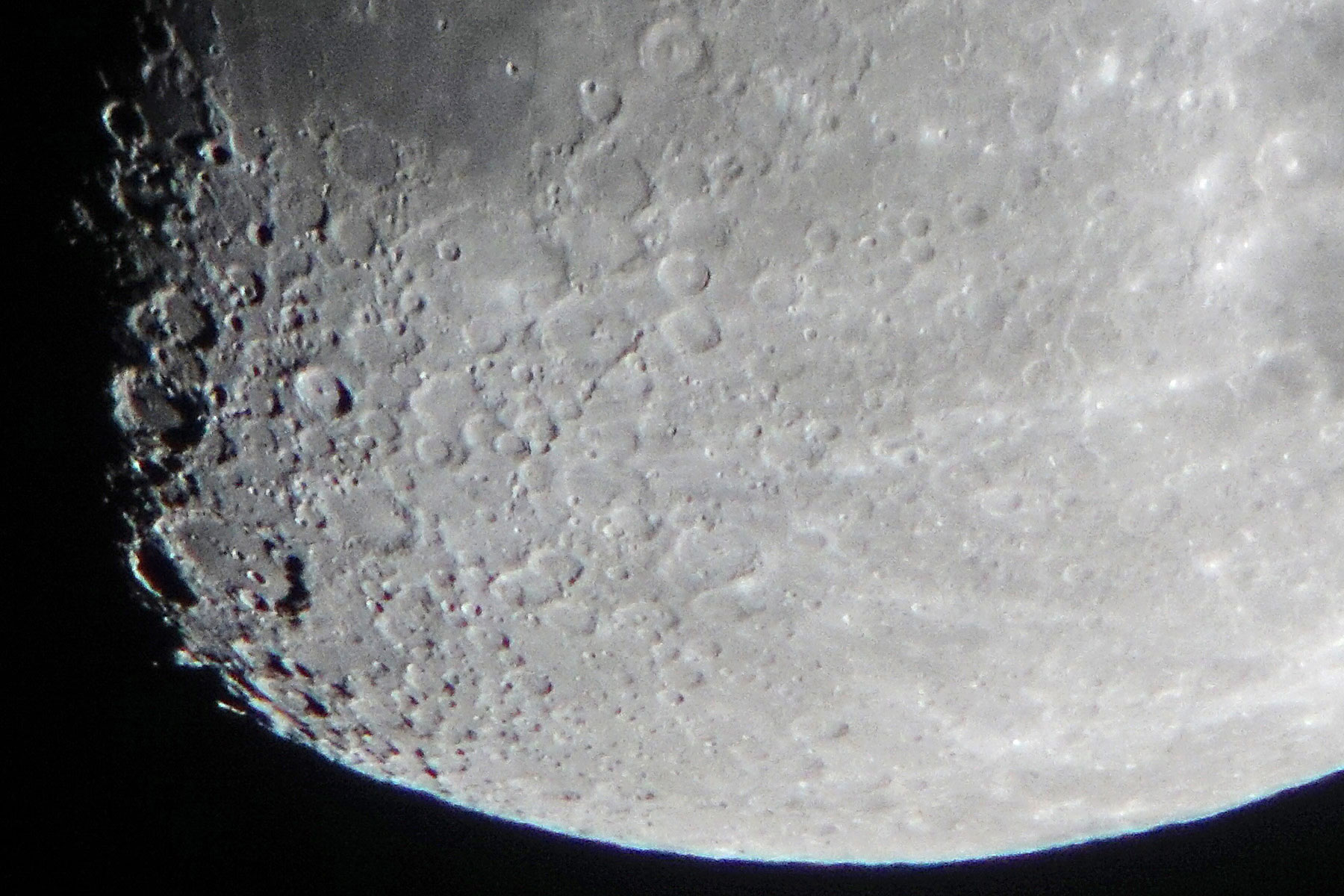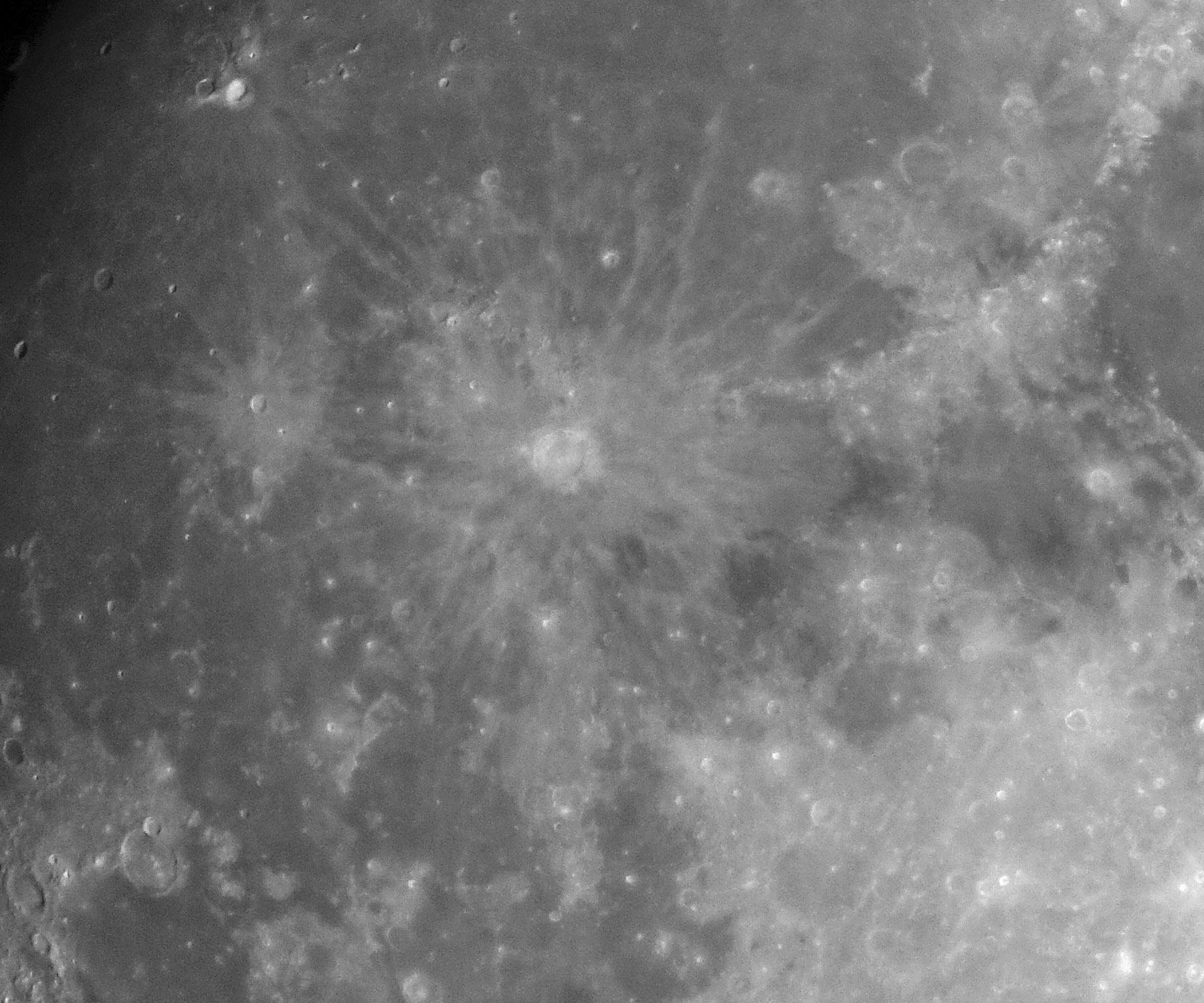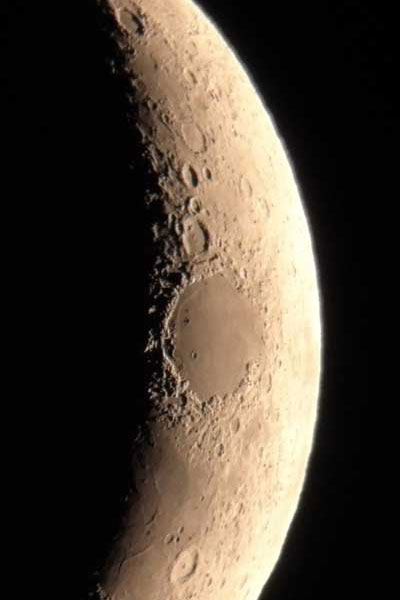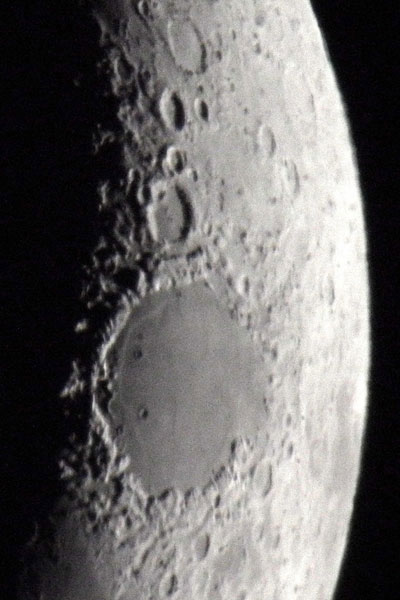Moon Alphabet - A-C
Introduction | A | B | C | References
On these pages I do "moon walks" on the basis of my own photos. In other words, I try to name the objects on my lunar photos to get to know the moon better. Maybe these pages will help others to get to know the moon better as well...
On this and further pages, I present selected surface elements (maria, craters, mountains) on the moon, or combinations of these in alphabetical order, thus, as a small "moon encyclopedia." Some of the photos are repeated because they contain several interesting objects; the current objects are labelled in yellow. The photos are rotated by 180 degrees or mirrored so that they correspond to the normal visual impression, but they are often somewhat skewed. I hope to be able to replace some photos with better ones in the course of time...
Notes
- The initial selection of objects was guided by Lambert Spix' book "moonscout," but probably more elements will be added some day...
- The description of the general elements of the moon surface can be found on page Walking the Moon with my own Photos - Overview.
- See also pages Moon Alphabet - D-J, Moon Alphabet - K-R , Moon Alphabet - S-Z - Back to the overview of my "moon walks".
Sources
- Spix = Lambert Spix (2013, 3. Auflage). moonscout - Mondmeere, Krater und Gebirge einfach finden und beobachten
- S&G = Lambert Spix & Frank Gasparini (2011, 1. Auflage). Der Moonhopper
- VMA = Virtual Moon Atlas
For more information see the references.
Introduction
On this page and on a second one, I present landscapes on the moon, surface elements (maria, craters, mountains), or combinations of these in alphabetical order, thus, as a small "moon encyclopedia."
A
Albategnius
Ring mountains with a diameter of 130 km (Spix), or walled plain with a diameter of 136 km (VMA),and 3200 km deep (Spix). Located nearly at the center of the visible side of the moon; overlayed by a crater of 44 km diameter and 1460 m depth named "Klein;" the central mountain rises up for nearly 2000 m.
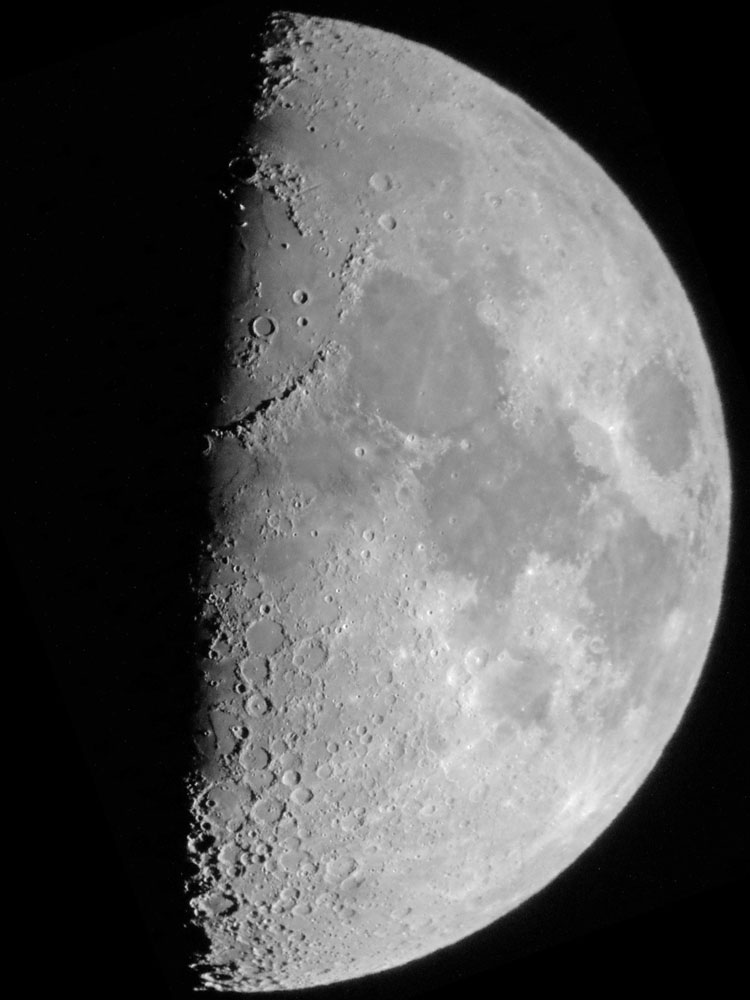 |
 |
|
Rotated a little... |
||
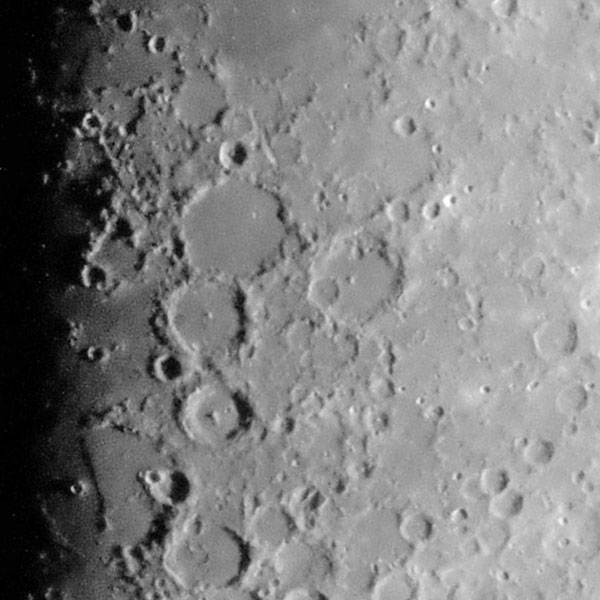 |
 |
|
100% section |
Albategnius and examples of small craters with diameter in km |
Photo data: February 23, 2018 late in the evening, Sky-Watcher Skymax-127 telescope, Ricoh GR held to the eyepiece
Alpes, Montes (Alps)
Mountains at the north-east border of Mare Imbrium with a height of 2500 m and a length of 300 km (Spix), on both sides of the Alps Valley.
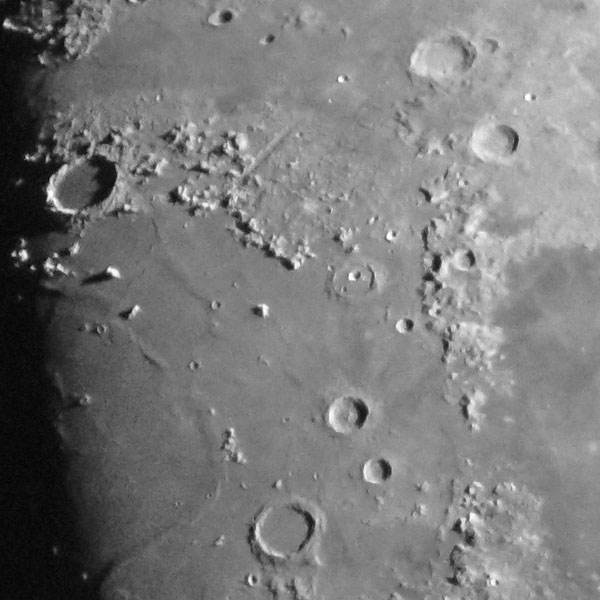 |
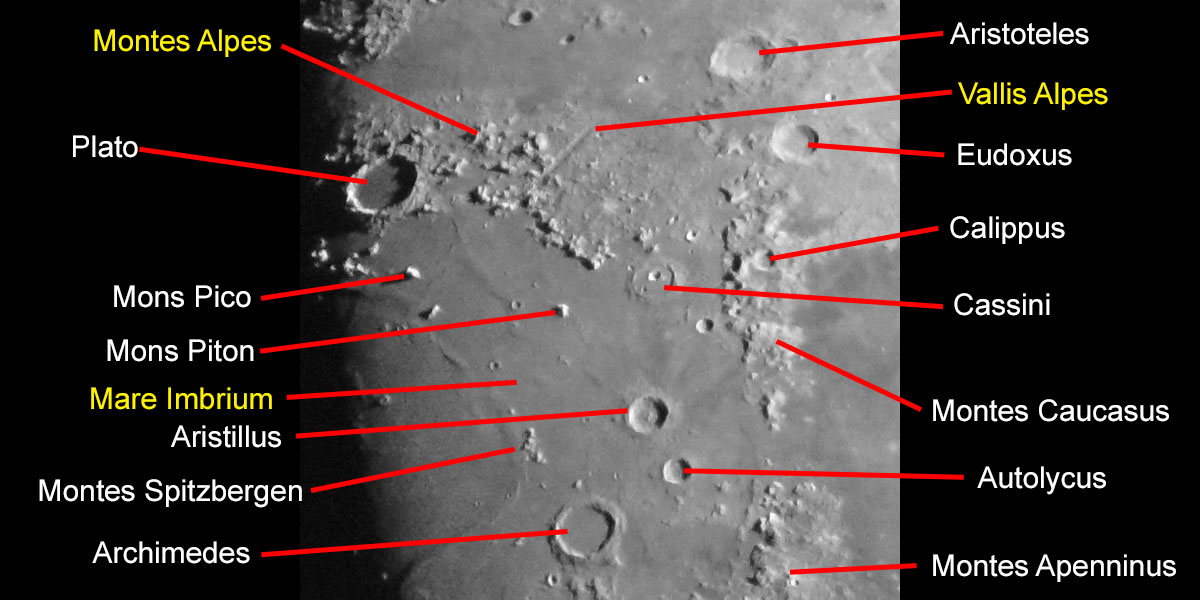 |
Photo data: March 25, 2018, Sky-Watcher Skymax-127 OTA, Sony RX100 M4 attached to the eyepiece
The following photos shows three mountain ranges at the eastern edge of Mare Imbrium: Montes Alpes, Montes Caucasus, and Montes Apenninus:
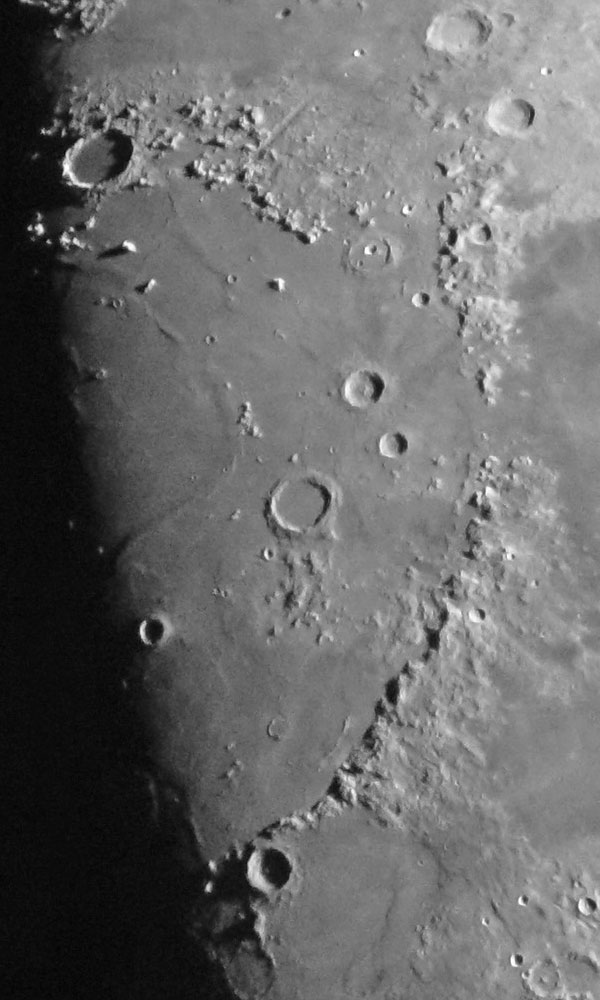 |
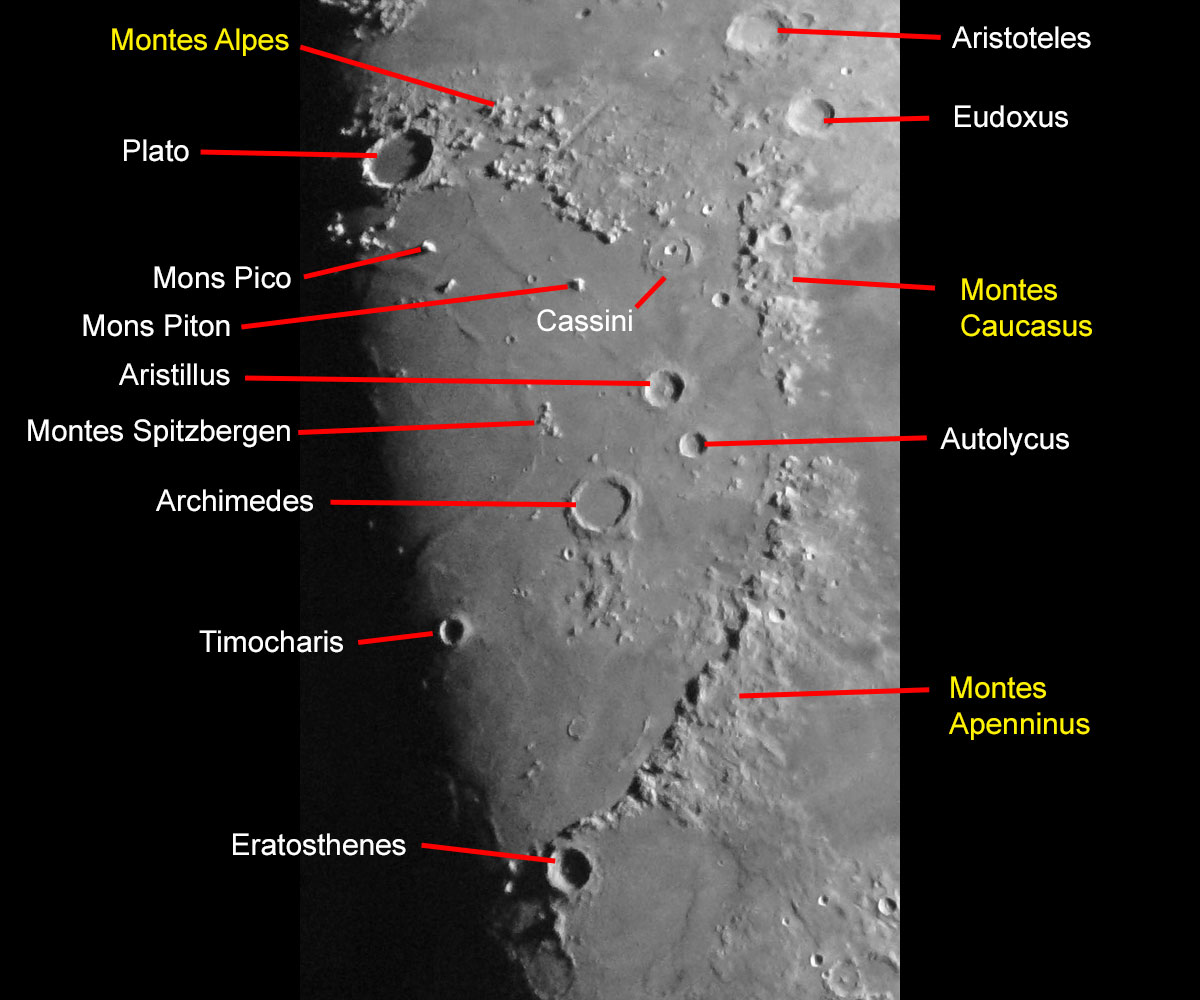 |
Photo data: March 25, 2018, Sky-Watcher Skymax-127 OTA, Sony RX100 M4 attached to the eyepiece
Alpes, Vallis (Alps Valley)
Valley of 155 km length and 1000 m depth that cuts through the Alps completely (Spix).
 |
 |
Photo data: March 25, 2018, Sky-Watcher Skymax-127 OTA, Sony RX100 M4 attached to the eyepiece
Alpetragius
Crater with a diameter of 40 km and a depth of 3900 m (Spix, VMA). Is located to the west and between the craters Alphonsus and Arzachel. As a specialty, it boast of a central mountain of a unique shape.
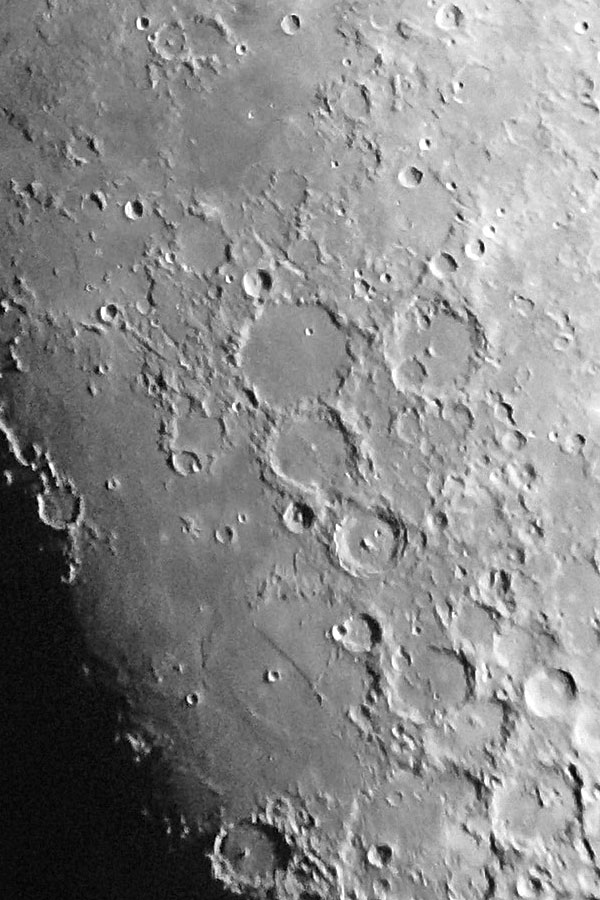 |
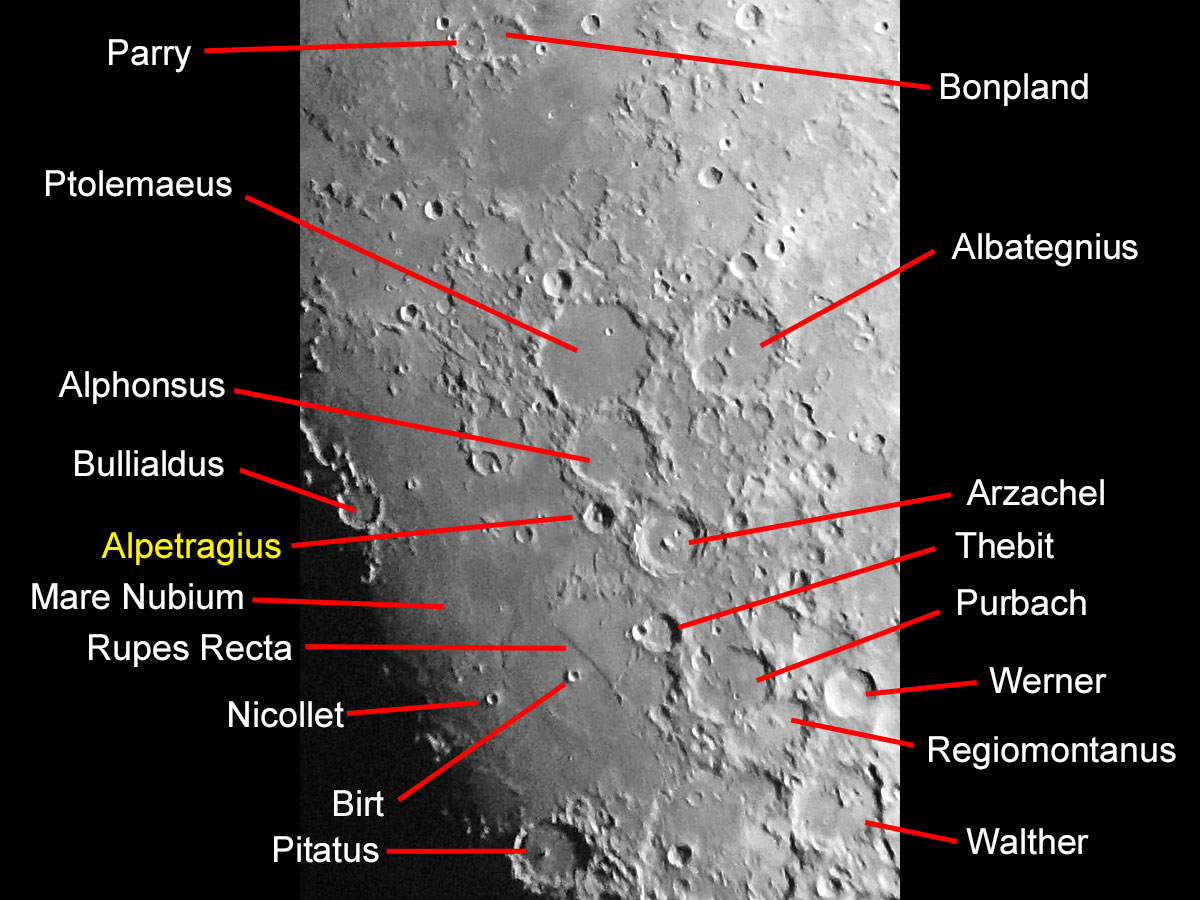 |
Photo data: March 25, 2018, Sky-Watcher Skymax-127 OTA, Sony RX100 M4 attached to the eyepiece
Alphonsus
Ring mountains with a diameter of 118 km (Spix), or crater with a diameter of 118 km (VMA), 2700 km deep (Spix). Located between the craters Ptolemaeus and Arzachel; together, the three form a beautiful crater chain. To the right of Ptolemaeus, you will find the walled plain Albategnius.
 |
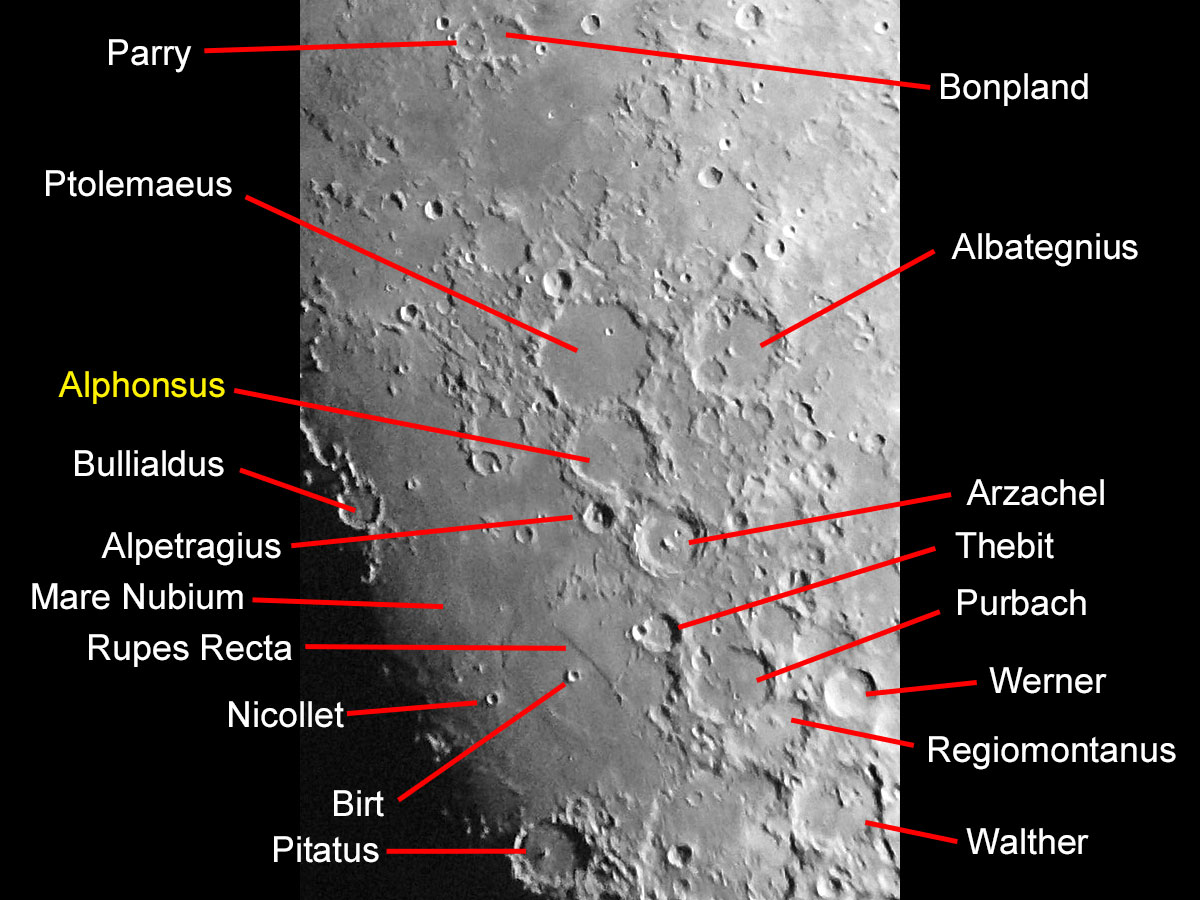 |
Photo data: March 25, 2018, Sky-Watcher Skymax-127 OTA, Sony RX100 M4 attached to the eyepiece
Altai, Rupes (Altai Fault)
Rupes Altai (Altai fault) is a cliff of 430 km length and up to 4000 m height (Spix) southwest of Mare Nectaris (Sea of the Nectar).
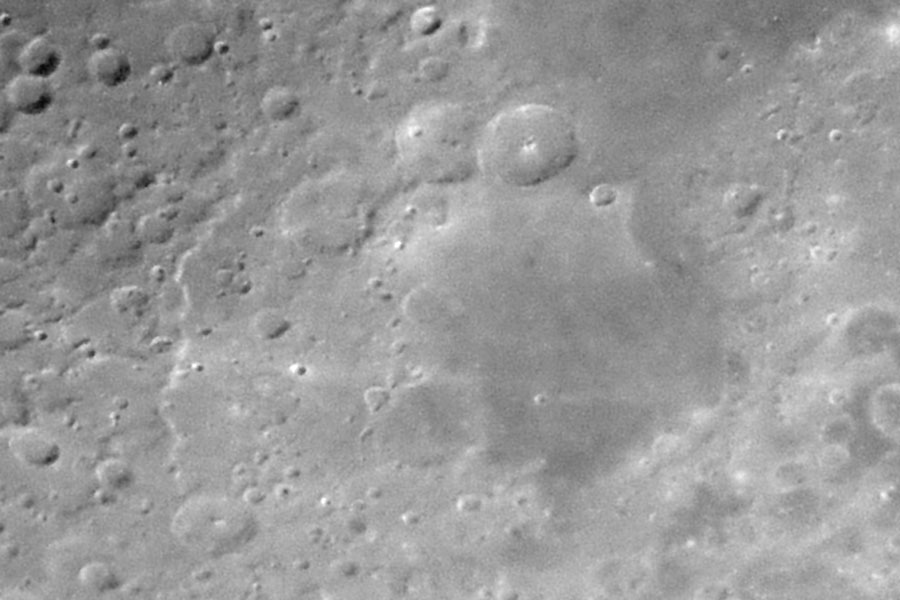 |
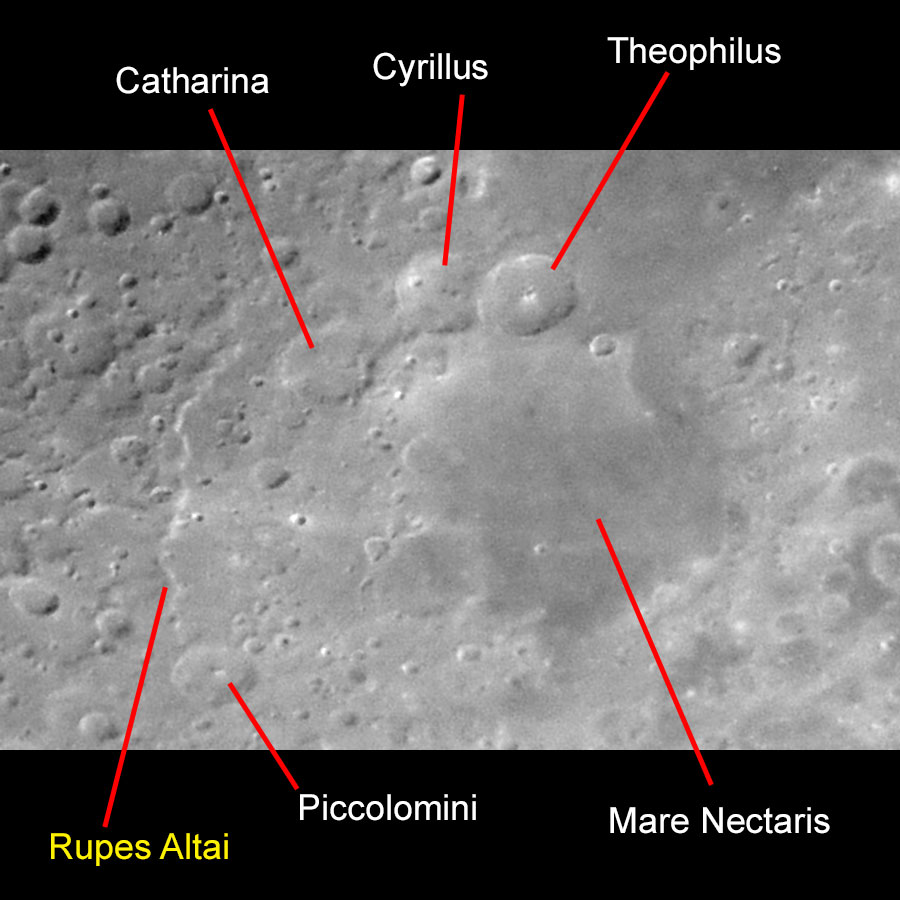 |
Photo data: March 24, 2018 (Half Moon), Sky-Watcher Eyplorer 150PDS, Ricoh GR held to the eyepiece
At the top you see the three craters Catharina, Cyrillus, and Theophilus (from left to right), in the middle Mare Nectaris, and at the left from top to bottom the fault Rupes Altai in the light of the rising sun. Below an "earlier" photo where the terminator is closer:
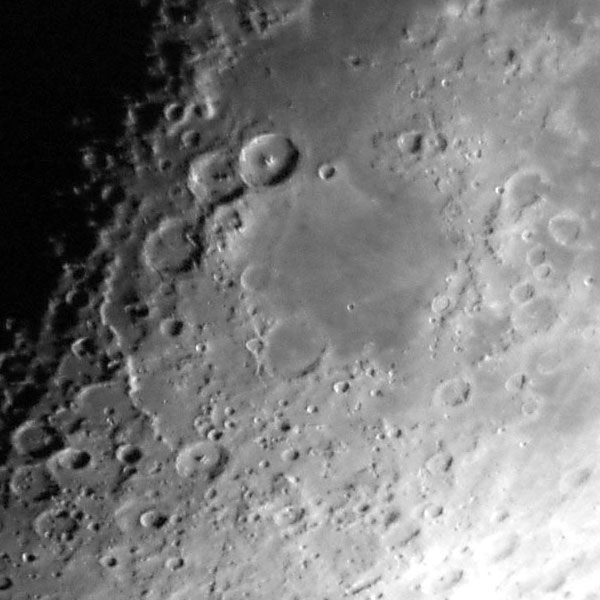 |
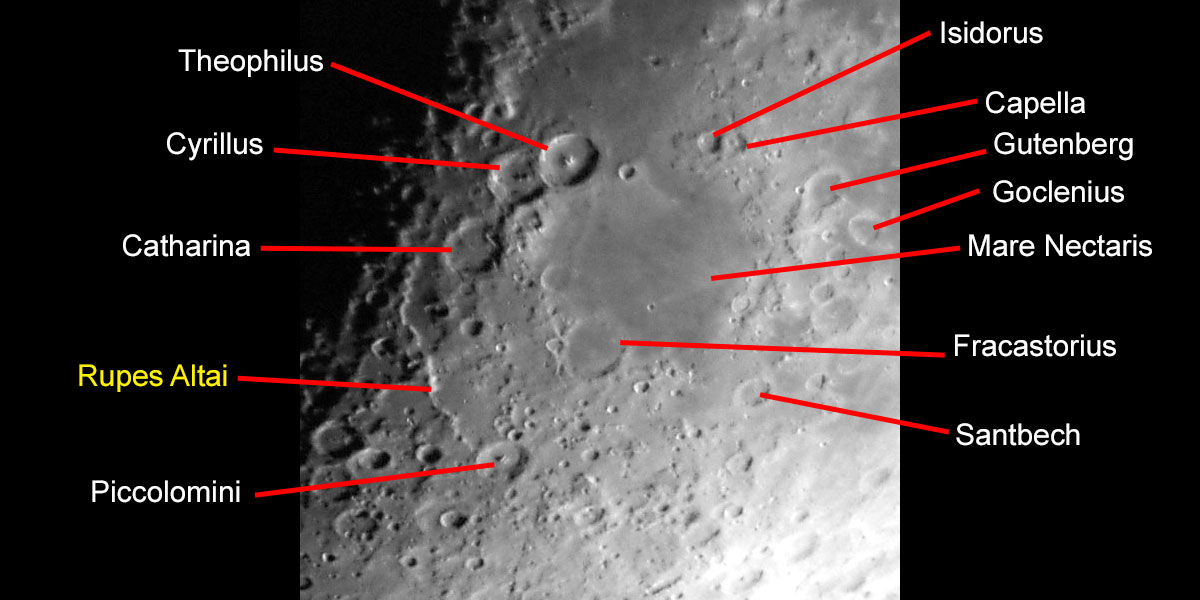 |
Photo data: April 2-3, 2017, Sky-Watcher Explorer 150PDS, Ricoh GR held to the 7 mm UWA eyepiece
Apenninus, Montes (Apennines)
The Apennines (Montes Apenninus) are a mountain range on the eastern edge of the Mare Imbrium (Sea of Rain) with an altitude of 5500 m and a length of 400 km (Spix). For me, it is the most impressive mountain range on the moon, and it is indeed the largest mountain range there.
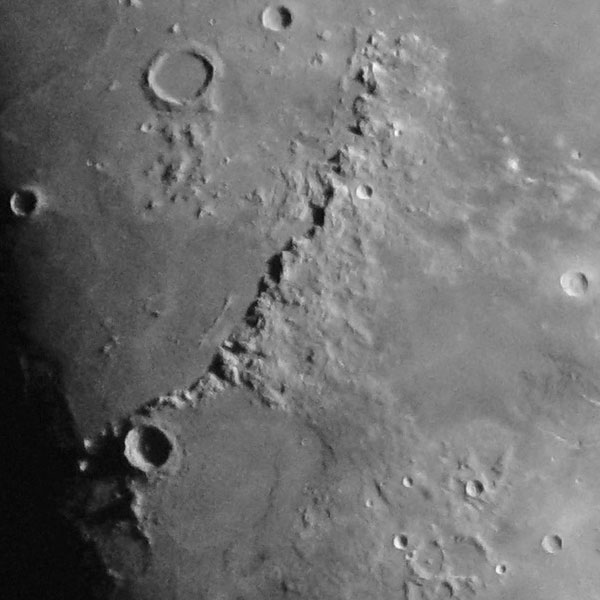 |
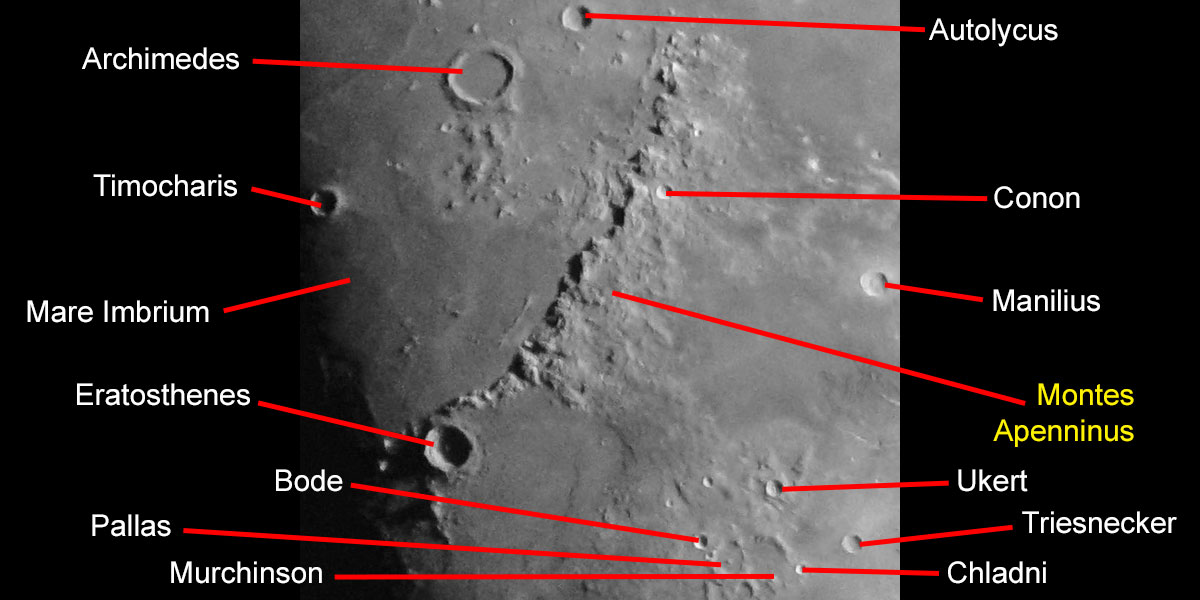 |
Photo data: March 25, 2018, Sky-Watcher Skymax-127 OTA, Sony RX100 M4 attached to the eyepiece
The following photos shows three mountain ranges at the eastern edge of Mare Imbrium: Montes Alpes, Montes Caucasus, and Montes Apenninus:
 |
 |
Photo data: March 25, 2018, Sky-Watcher Skymax-127 OTA, Sony RX100 M4 attached to the eyepiece
Archimedes
The crater Archimedes at the eastern edge of Mare Imbrium has a diameter of 81 km, a depth of 1600 m, and a wall of up to 2000 height (Spix), or 83 km and 2150 m height (VMA).
 |
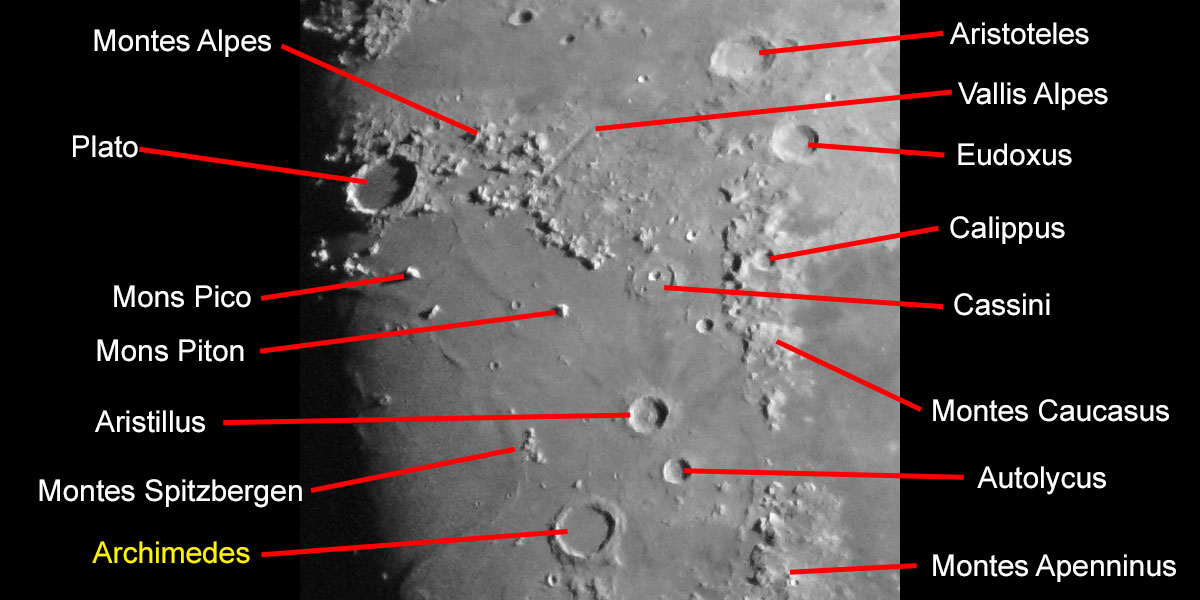 |
Photo data: March 25, 2018, Sky-Watcher Skymax-127 OTA, Sony RX100 M4 attached to the eyepiece
Aristarchus
Aristarchus is a smaller crater with a diameter of 40 km and a depth of 3100 m (Spix). It is said to be the brightest visible crater, and some people can even recognize it with the naked eye when it is in the shade. The following overview photo (left) shows Aristarchus as the brightest spot on the moon:
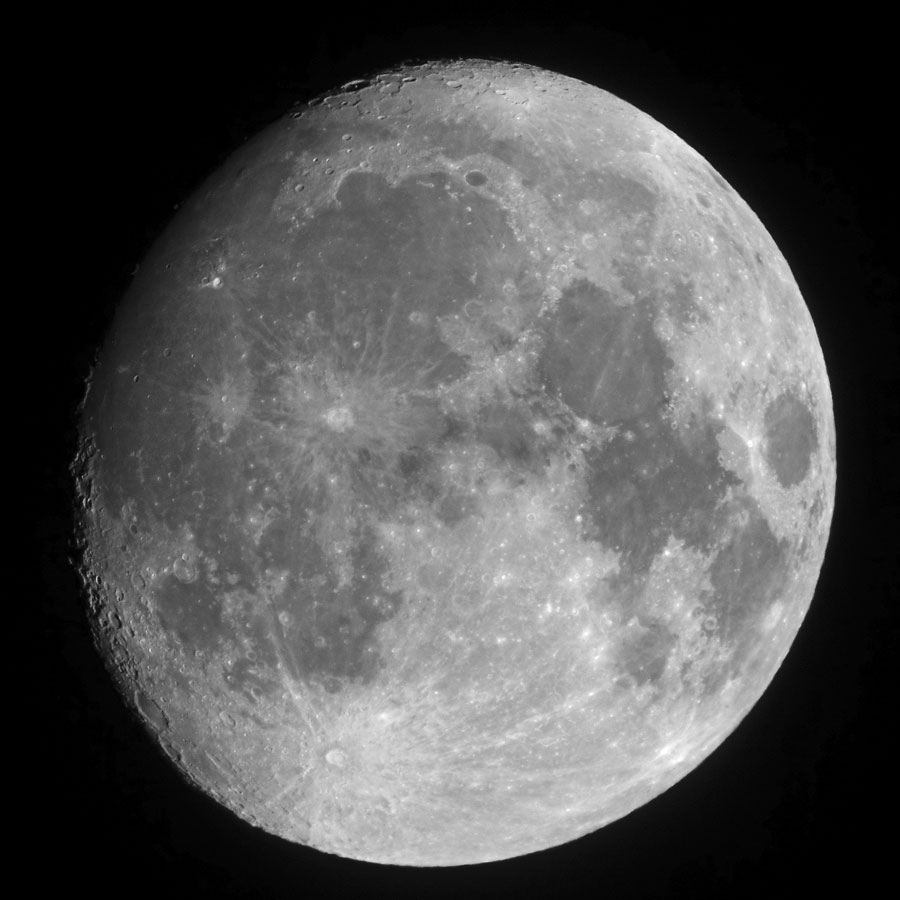 |
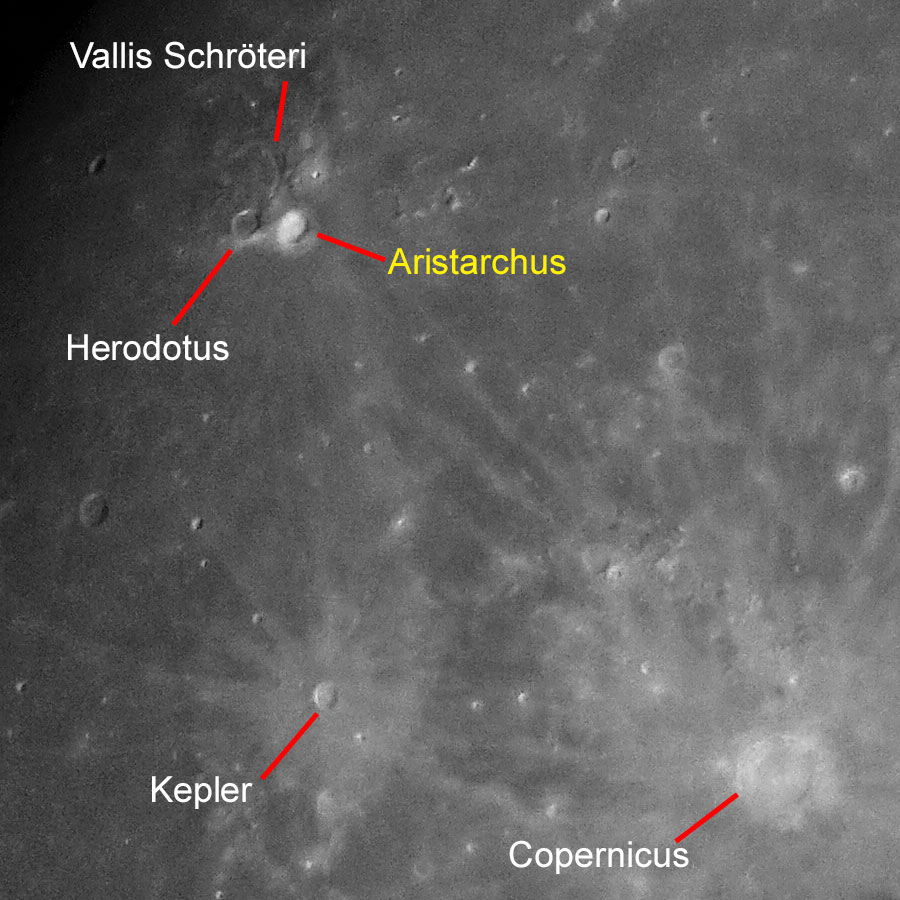 |
Photo data: November 20, 2018, Omegon PS 72/432 refractor on Sky-Watcher AZ Pronto mount, Sony RX100 M4 attached to the 32 mm eyepiece, 3 x focal extender
Aristillus
The 55 km in diameter large and 3300 m high ring mountains Aristillus and its smaller partner Aristillus are located above (northeast) the crater Archimedes in the eastern part of Mare Imbriums (Sea of Rain) approximately on the height, where the Montes Caucasus end and the Montes Apenninus begin.
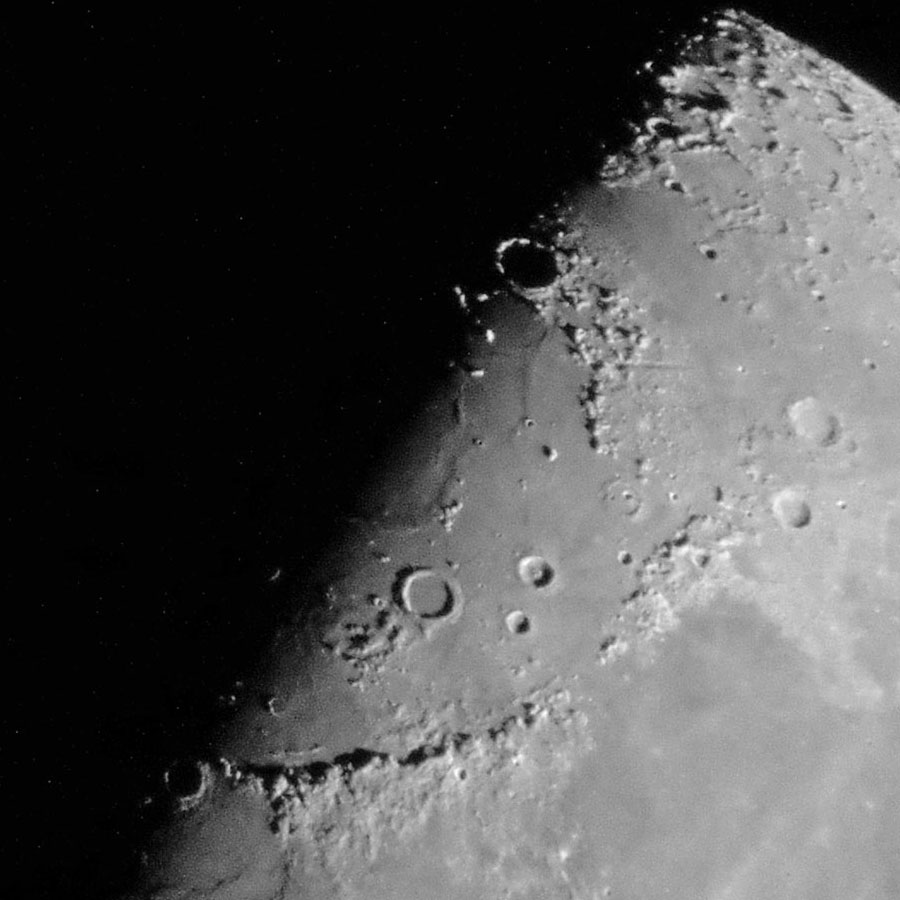 |
 |
Photo data: February 23, 2018, Sky-Watcher Skymax-102 OTA, Ricoh GR held to the eyepiece
 |
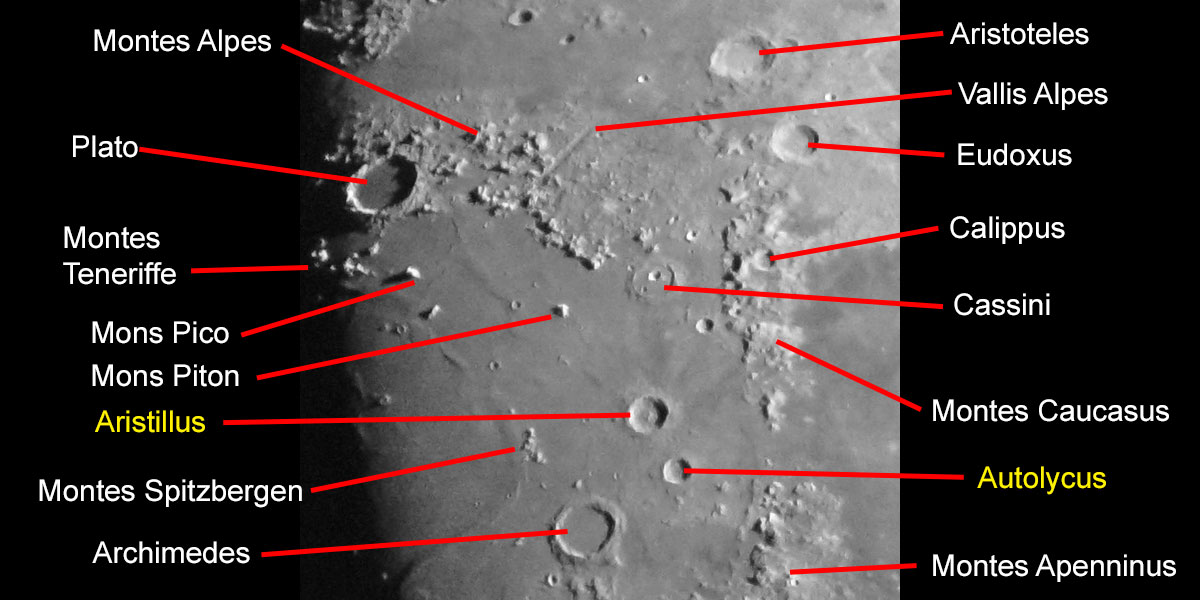 |
Photo data: March 25, 2018, Sky-Watcher Skymax-127 OTA, Sony RX100 M4 attached to the eyepiece
Aristoteles
The crater Archimedes northeast of Mare Imbrium has a diameter of 87 km and a depth of 3500 m (Spix), or 87-88 km and 3700 m height (VMA).
 |
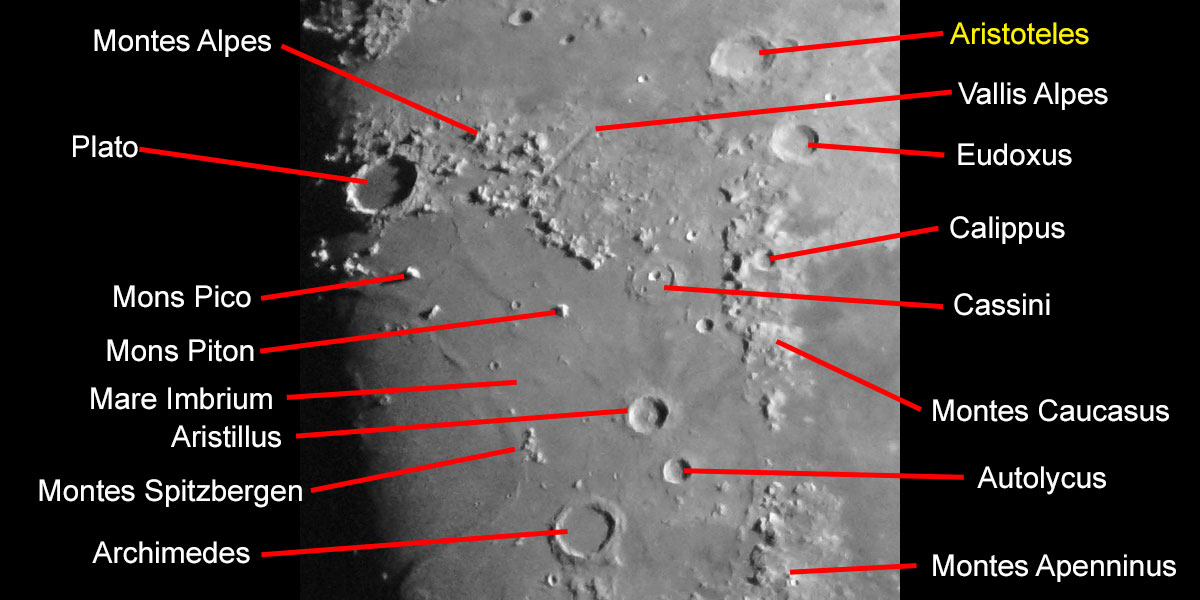 |
Photo data: March 25, 2018, Sky-Watcher Skymax-127 OTA, Sony RX100 M4 attached to the eyepiece
Arzachel
Crater with a diameter of 97 km (Spix), or 97-98 km (VMA), 3500 km deep (Spix). Located south of the craters Ptolemaeus and Alphonsus; together, the three form a beautiful crater chain. To the right of Ptolemaeus, you will find the walled plain Albategnius.
 |
 |
Photo data: March 25, 2018, Sky-Watcher Skymax-127 OTA, Sony RX100 M4 attached to the eyepiece
Atlas
The crater Atlas can already be seen a few days after New Moon and, together with Hercules, appears as a pair of craters. Atlas is 87 km in diameter and 2000 m deep (Spix; 87/88 km and 3000 m according to VMA).
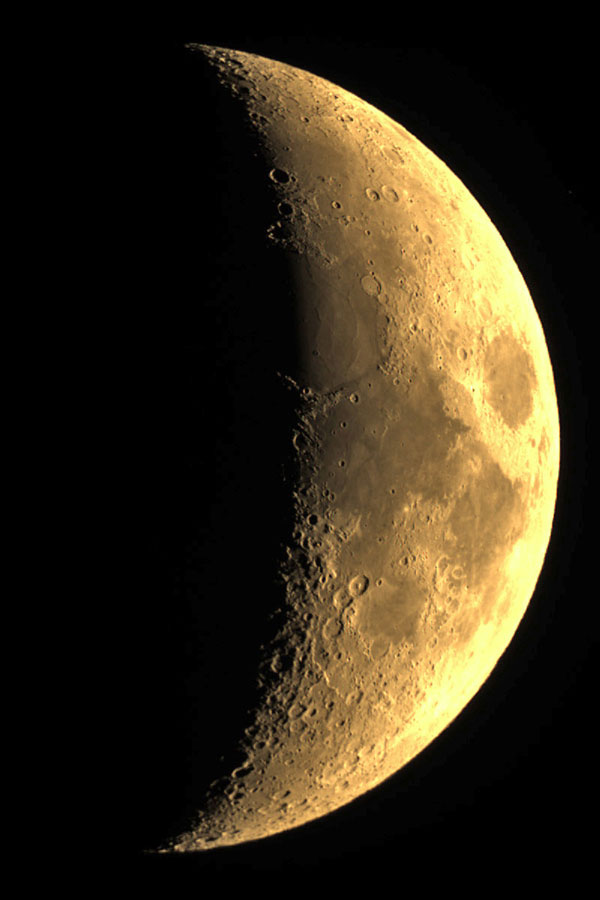 |
 |
Photo data: February 21, 2018, Sky-Watcher Explorer 150PDS telescope, Atik Inifinity camera
For more photos see Hercules.
Autolycus
The 39 km in diameter large and 3400 m high ring mountains Autolycus and its larger partner Aristillus are located above (northeast) the crater Archimedes in the eastern part of Mare Imbriums (Sea of Rain) approximately on the height, where the Montes Caucasus end and the Montes Apenninus begin.
 |
 |
Photo data: February 23, 2018, Sky-Watcher Skymax-102 OTA, Ricoh GR held to the eyepiece
 |
 |
Photo data: March 25, 2018, Sky-Watcher Skymax-127 OTA, Sony RX100 M4 attached to the eyepiece
B
Bullialdus
The crater Bullialdus has a diameter of 61 km and a depth of 3510 m (S&G, VMA). According to Spix & Gasparini, it is similar to the crater Copernicus, but lacks a system of rays. South of Bullialdus, there are the small craters Bullialdus A (26 km) and B (32 km). My first photo shows the crater close to the terminator, the second one a little farther away, and the third one a few days later and therefore less prominent.
 |
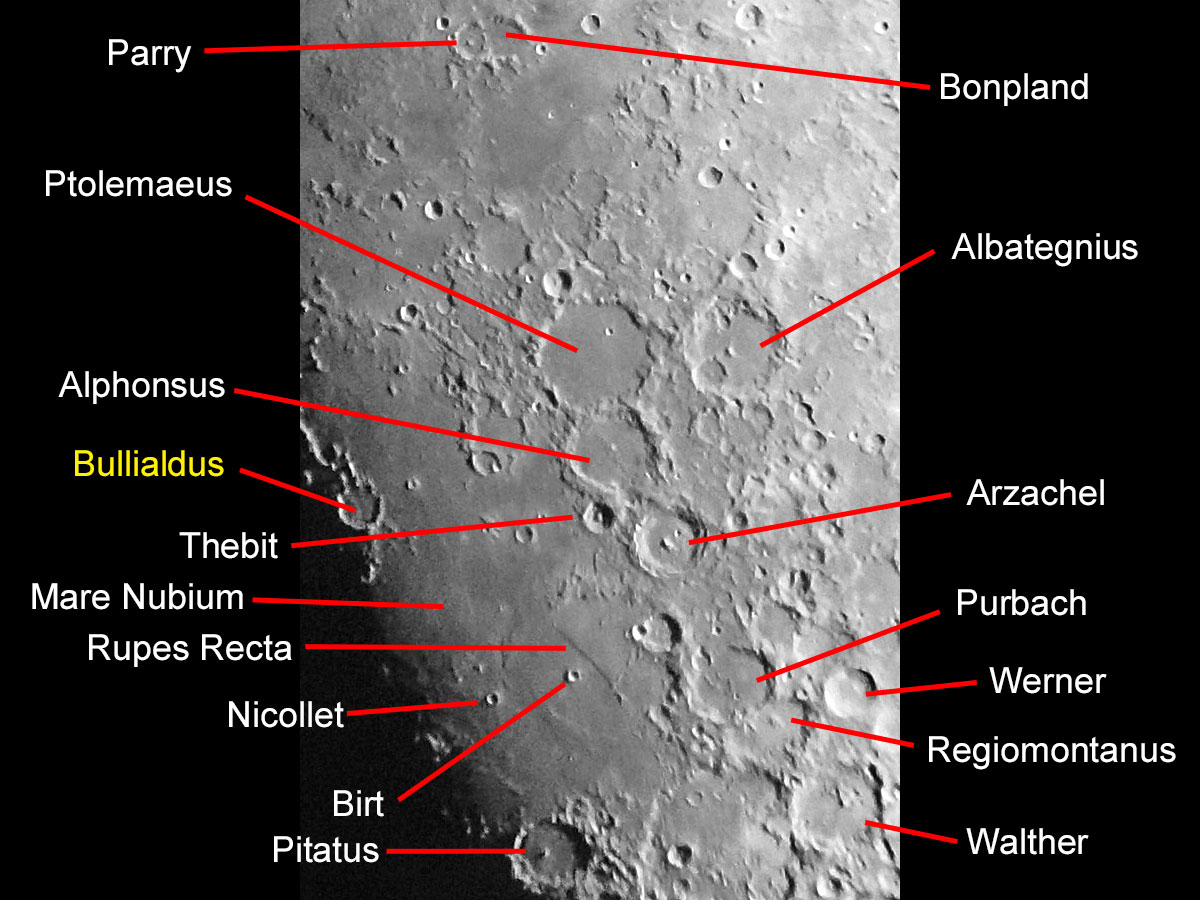 |
Photo data: March 25, 2018, Sky-Watcher Skymax-127 OTA, Sony RX100 M4 attached to the eyepiece
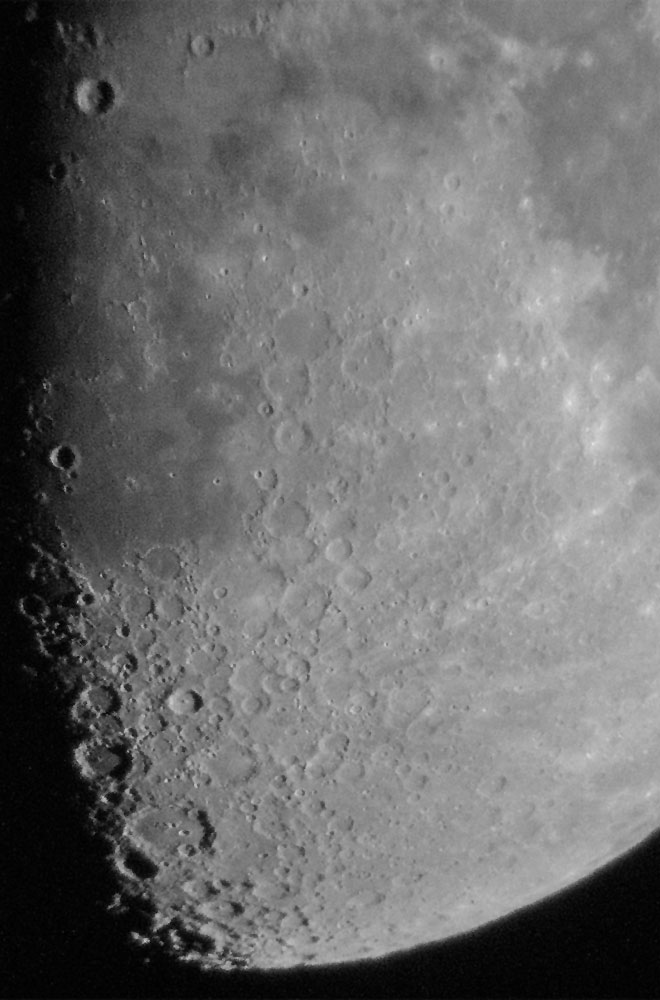 |
 |
Photo data: July 2015, Sky-Watcher Heritage 100P telescope, Leica X Vario held to the 32 mm Digiscope eyepiece
 |
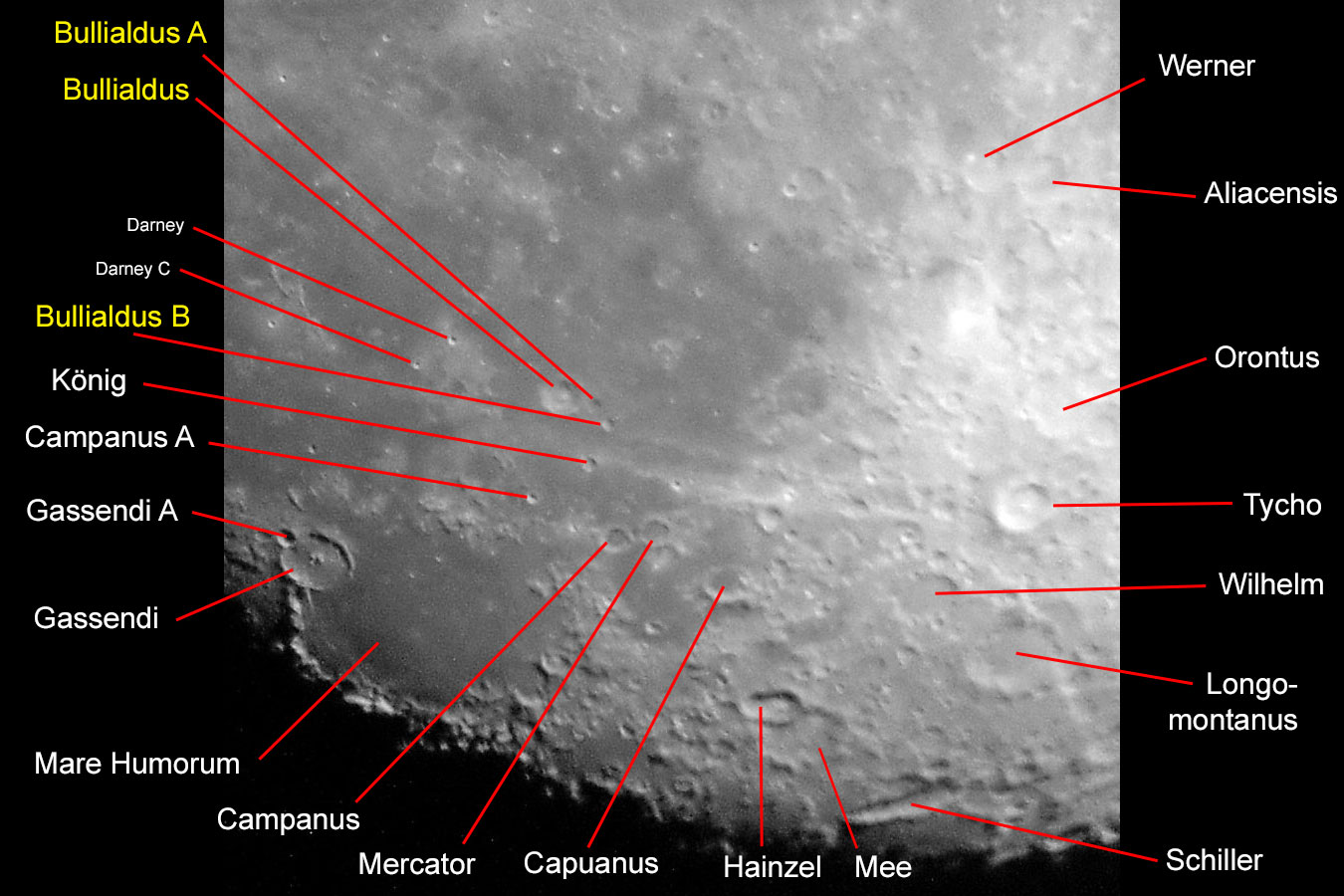 |
Photo data: February 26, 2018, Sky-Watcher Skymax-102 OTA, Ricoh GR held to the eyepiece
C
Carpatus, Montes (Carpates)
Above and to the left of Copernicus you will find the Montes Carpatus with a length of 360 km and a height of up to 2400 m (Spix).
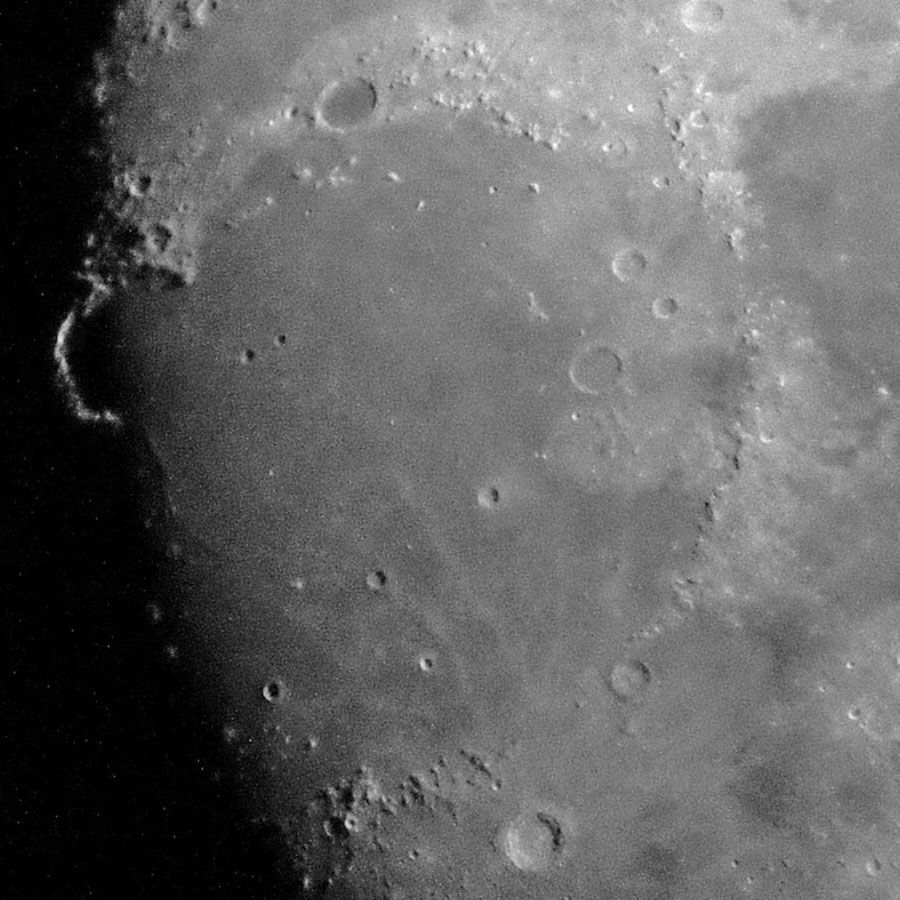 |
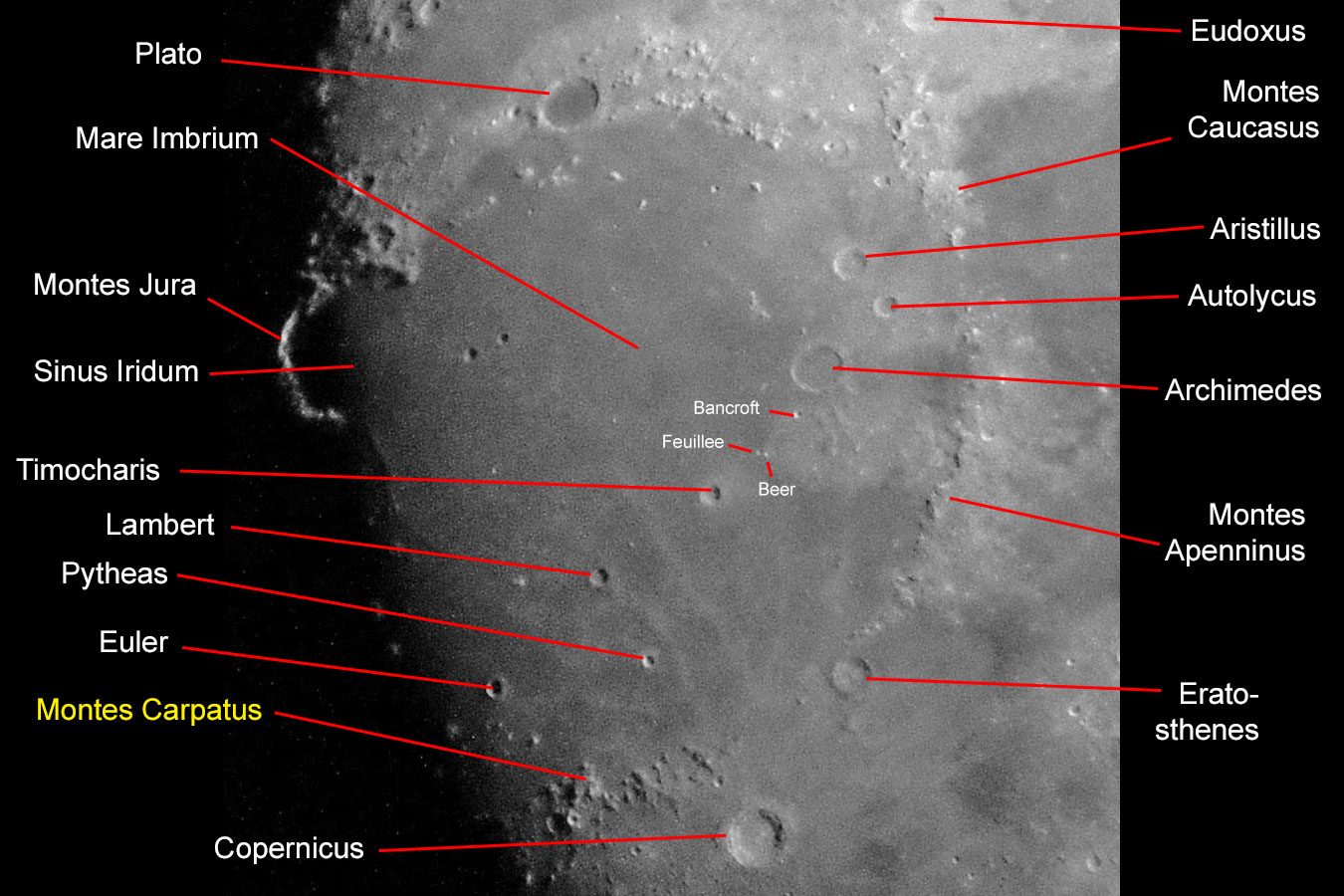 |
Photo data: February 25, 2018, Sky-Watcher Skymax-102 telescope, Ricoh GR held to the eyepiece
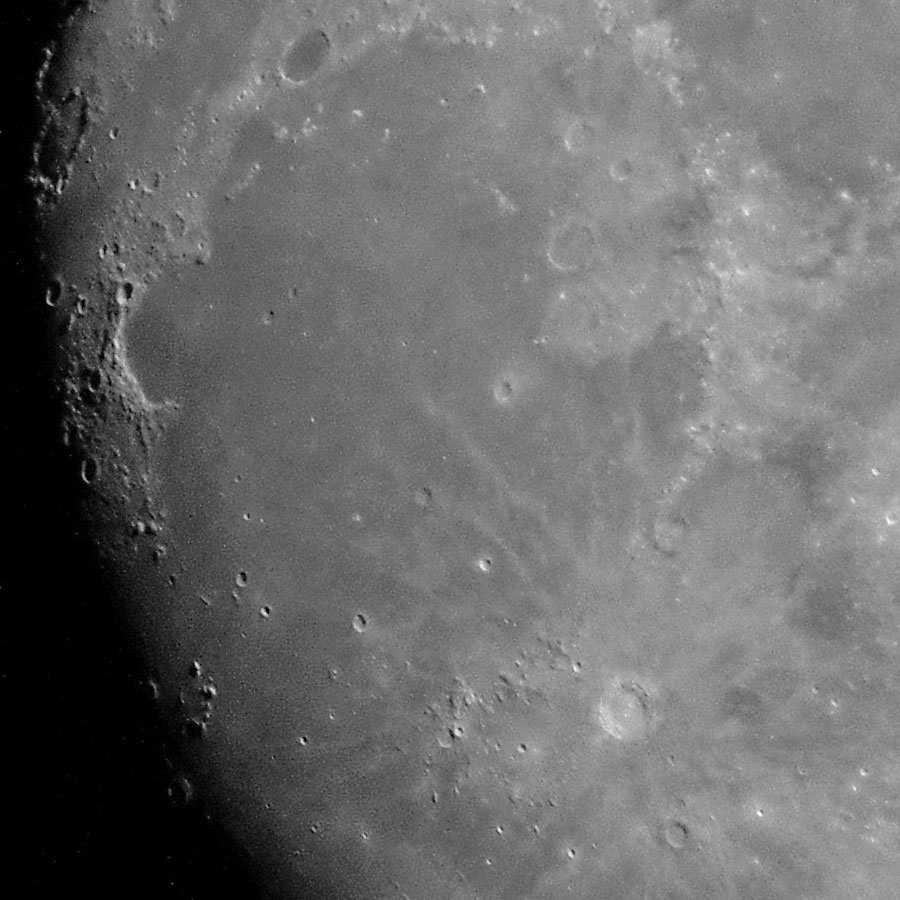 |
 |
Photo data: February 26, 2018, Sky-Watcher Skymax-102 telescope, Ricoh GR held to the eyepiece
Cassini
Crater with a diameter of 56 km and 1200 m depth (Spix), or with 58 km diameter and 1240 m height (VMA), situated between Montes Alpes and Montes Caucasus at the northeast edge of Mare Imbrium. To the left (west) of Cassini you will find the 2500 m (or 2250 m) high mountain Mons Piton.
 |
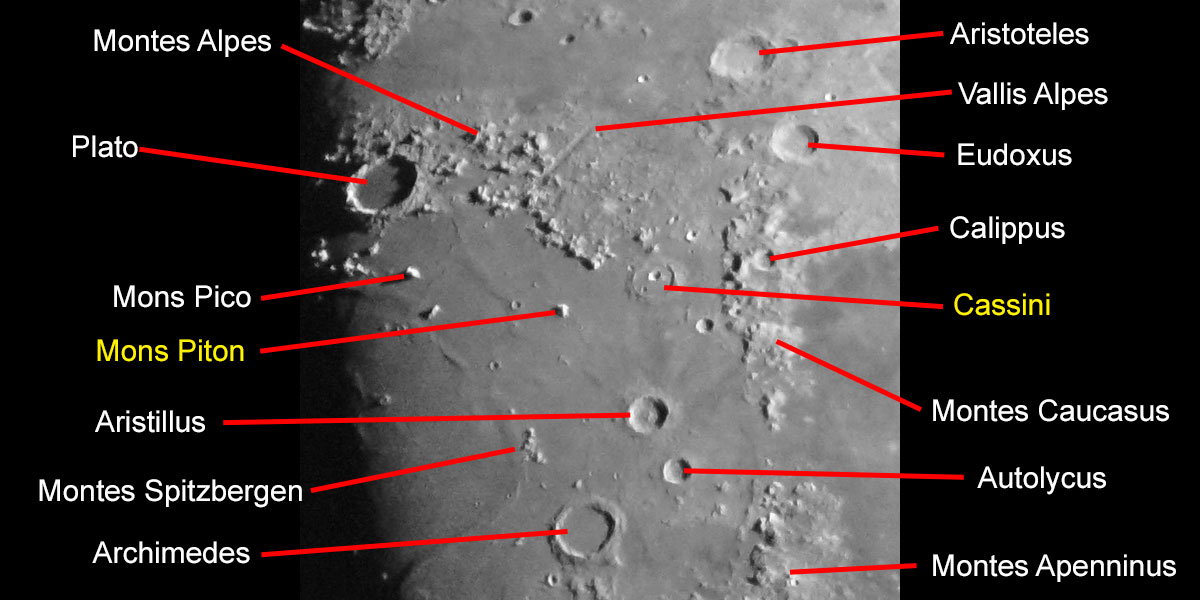 |
Photo data: March 25, 2018, Sky-Watcher Skymax-127 OTA, Sony RX100 M4 attached to the eyepiece
Catharina
The ring mountains (crater) Catharina has a diameter of 104 km and is 3100 m deep (Spix) or 100/101 km and 3130 m (VMA). It is the last in a chain of three craters called Theophilus, Cyrillus, and Catharina at the northwestern edge of Mare Nectaris (Sea of Nectar).
 |
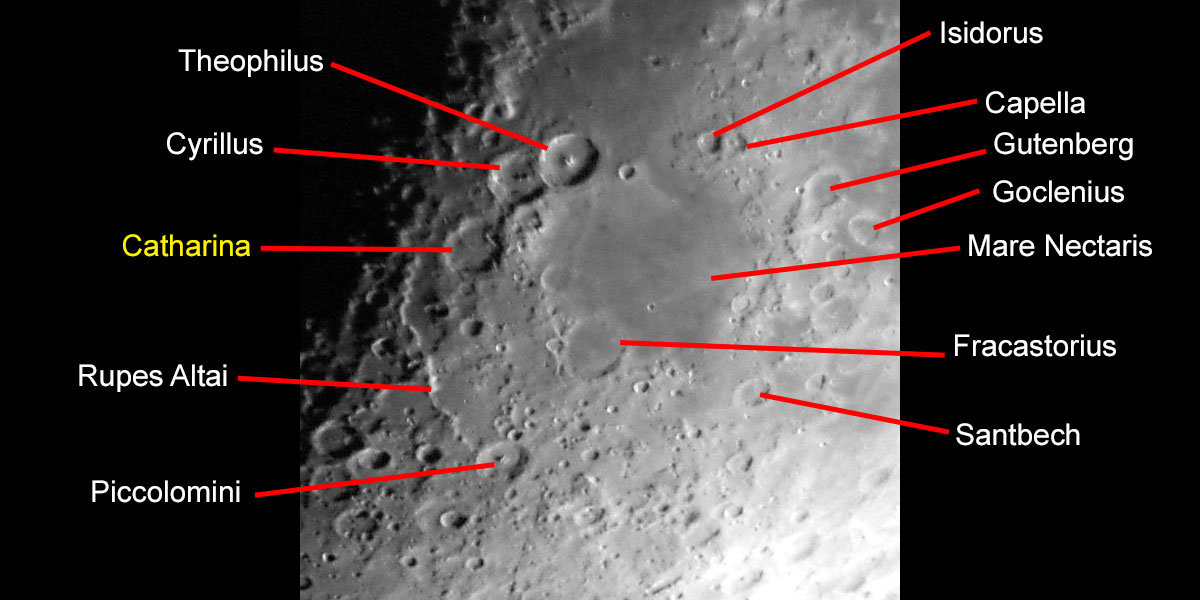 |
|
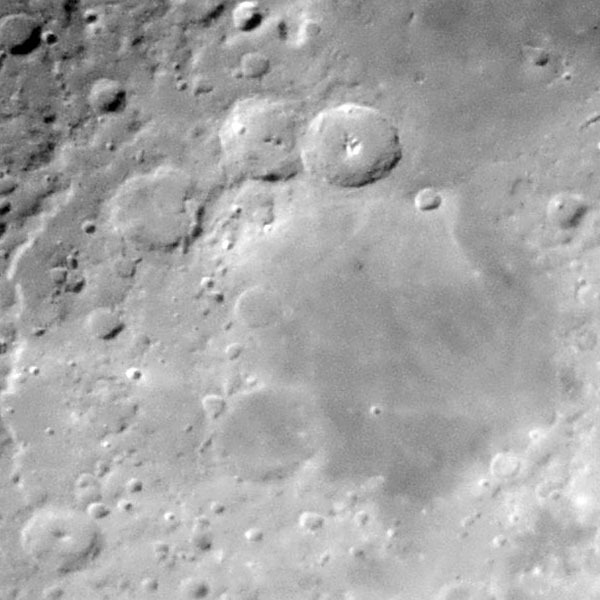 |
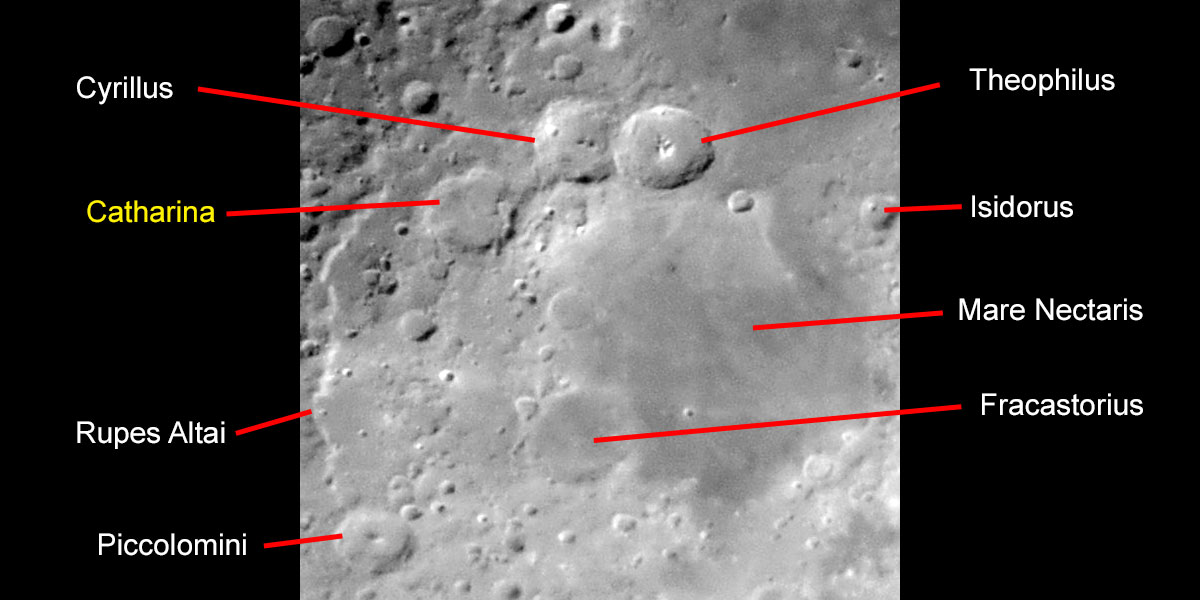 |
Photo data: April 2-3, 2017, Sky-Watcher Explorer 150PDS, Ricoh GR held to the 7 mm UWA eyepiece
Caucasus, Montes (Caucasus)
Mountain range at the northeast border of Mare Imbrium with a height of 4000 m and a length of 445 km (Spix).
 |
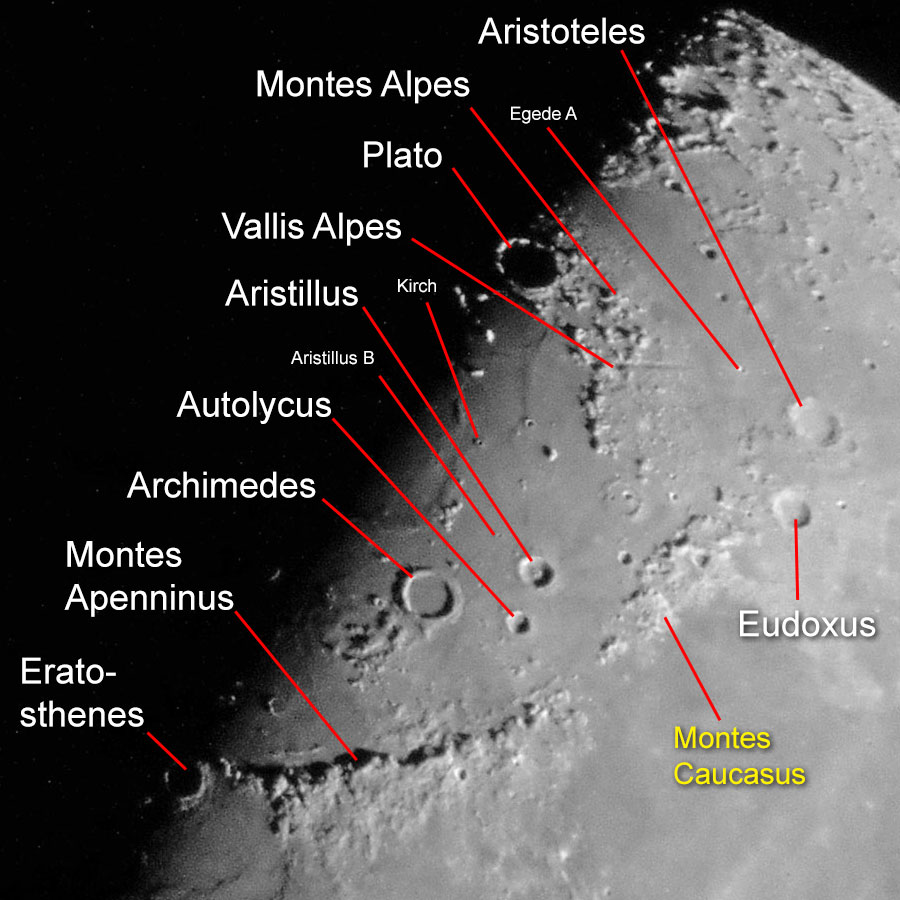 |
Photo data: February 23, 2018, Sky-Watcher Skymax-102 OTA, Ricoh GR held to the eyepiece
 |
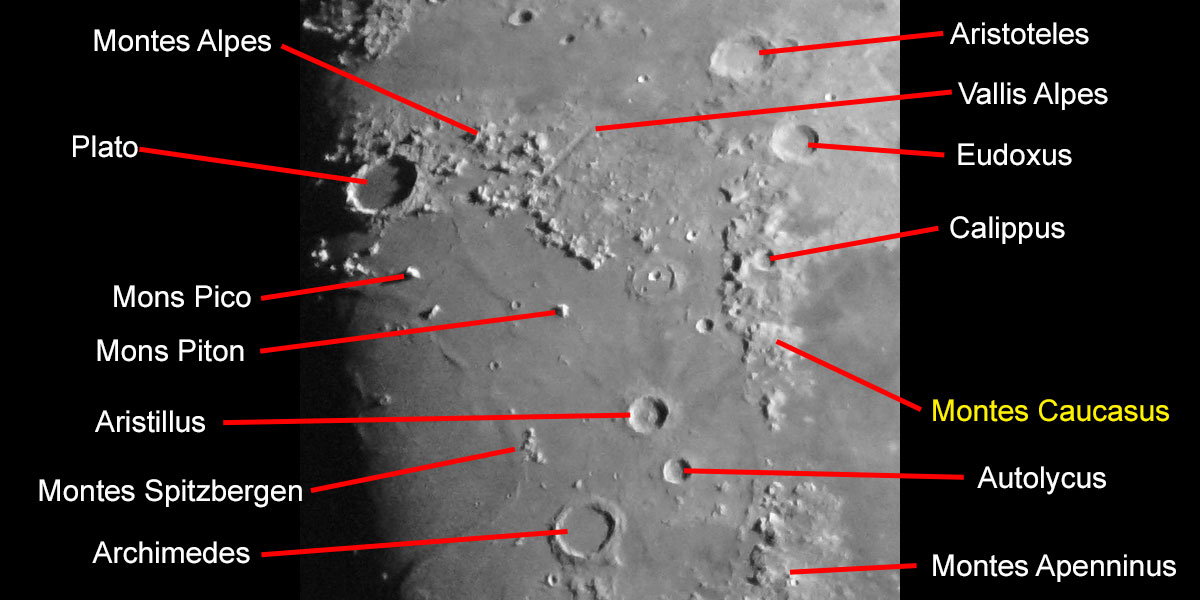 |
Photo data: March 25, 2018, Sky-Watcher Skymax-127 OTA, Sony RX100 M4 attached to the eyepiece
The following photos shows three mountain ranges at the eastern edge of Mare Imbrium: Montes Alpes, Montes Caucasus, and Montes Apenninus:
 |
 |
Photo data: March 25, 2018, Sky-Watcher Skymax-127 OTA, Sony RX100 M4 attached to the eyepiece
Clavius
The walled plain Clavius is located in the south of the moon and has a diameter of 245 km and a depth of 3600 m (Spix; 225 km according to VMA). Especially noticeable is a curved chain of five ever smaller craters. The crater wall is covered by impacts as well.
 |
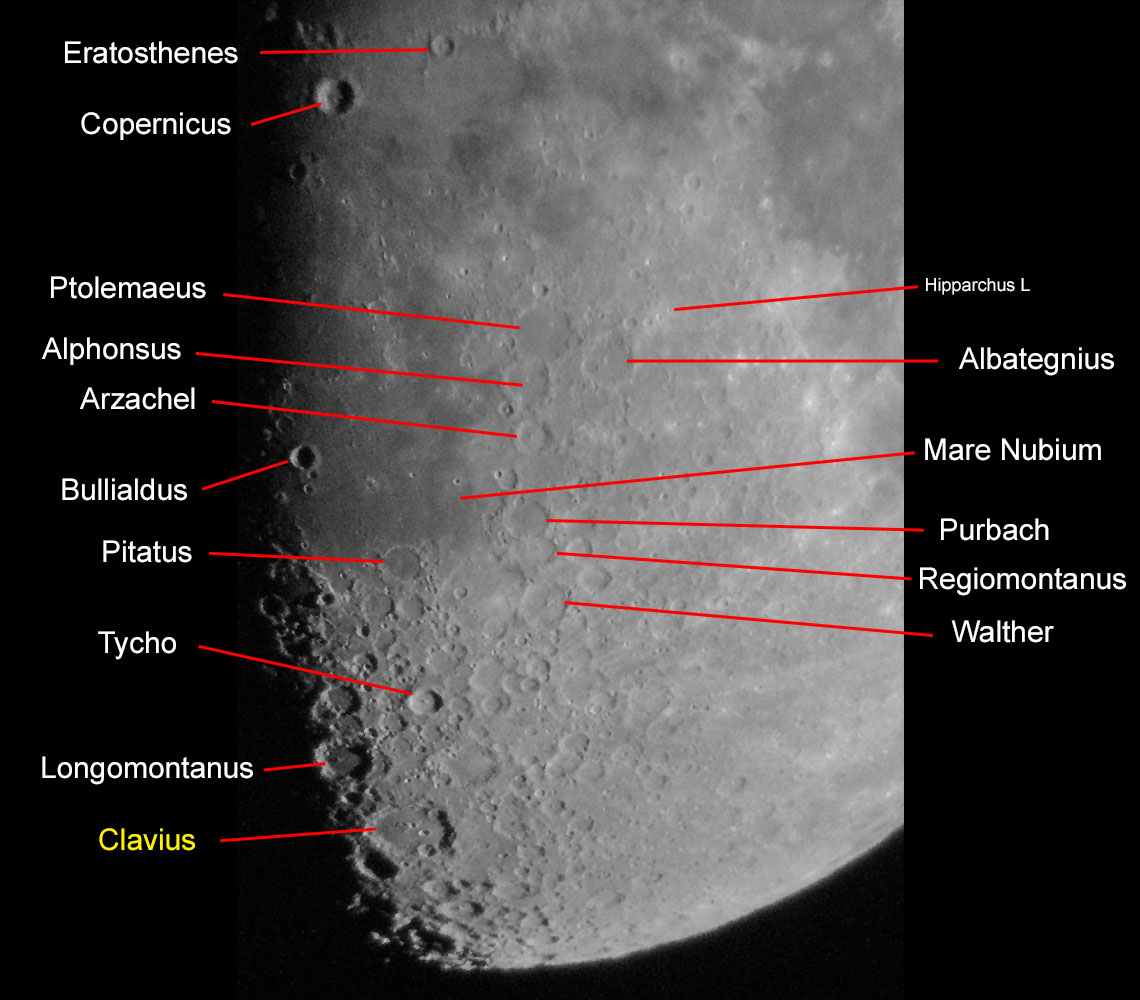 |
Photo data: July 2015, Sky-Watcher Heritage 100P telescope, Leica X Vario held to the 32 mm Digiscope eyepiece
Here is a larger photo of Clavius:
Photo data: November 17, 2018, Omegon PS 72/432 refractor, Sony RX100 M4 attached to the 32 mm Digiscope eyepiece, 3 x focal extender (40.5 x)
Cleomedes
Crater Cleomedes just above Mare Crisium has a diameter of 126 km and a depth of 2700 m (Spix).
 |
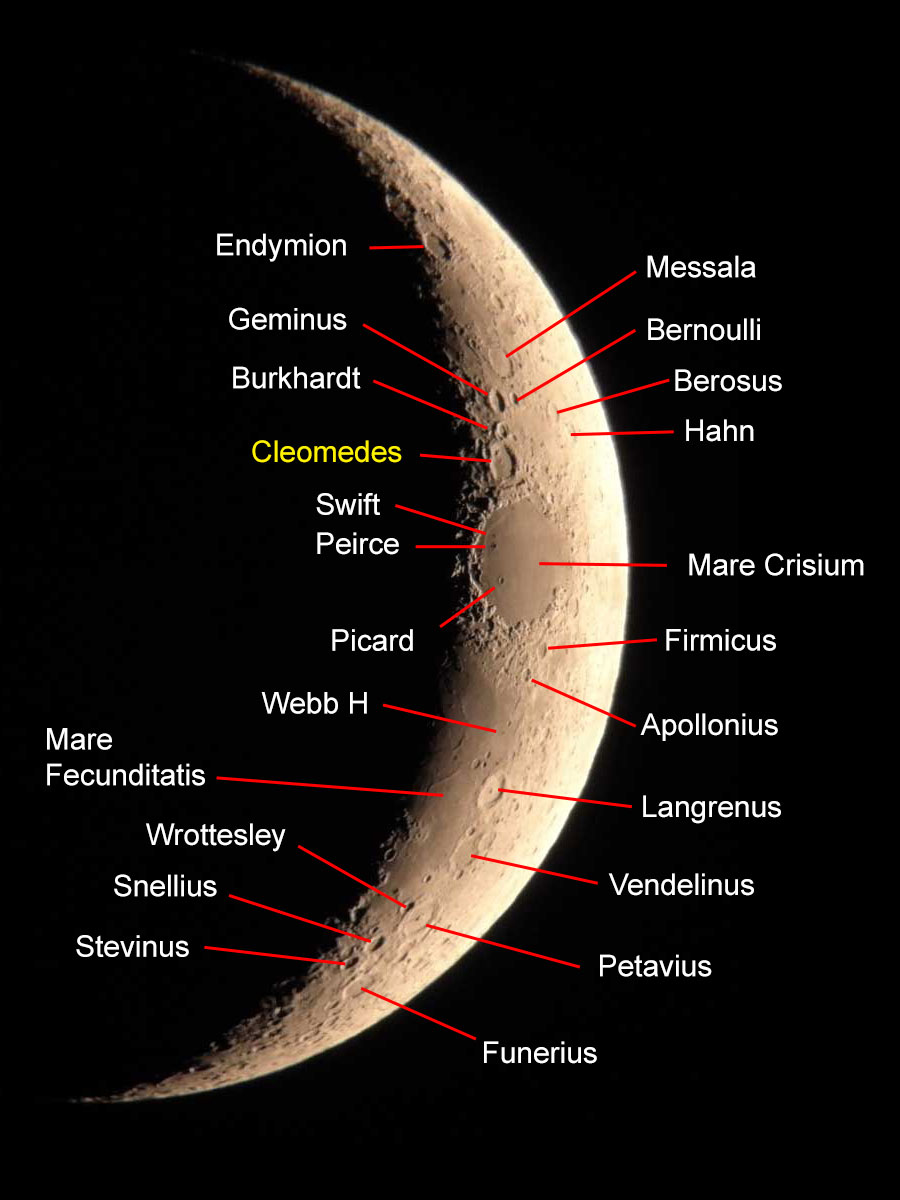 |
Photo data: April 10, 2016, GSO GSD 680 telescope, Leica X Vario mounted fix to 32 mm DigiScope eyepiece
Cognitum, Mare (Sea of ...)
Mare Cognitum (diameter 350 km according to Spix) originally belonged to Mare Nubium and cannot be easily recogized as a sea of its own.
 |
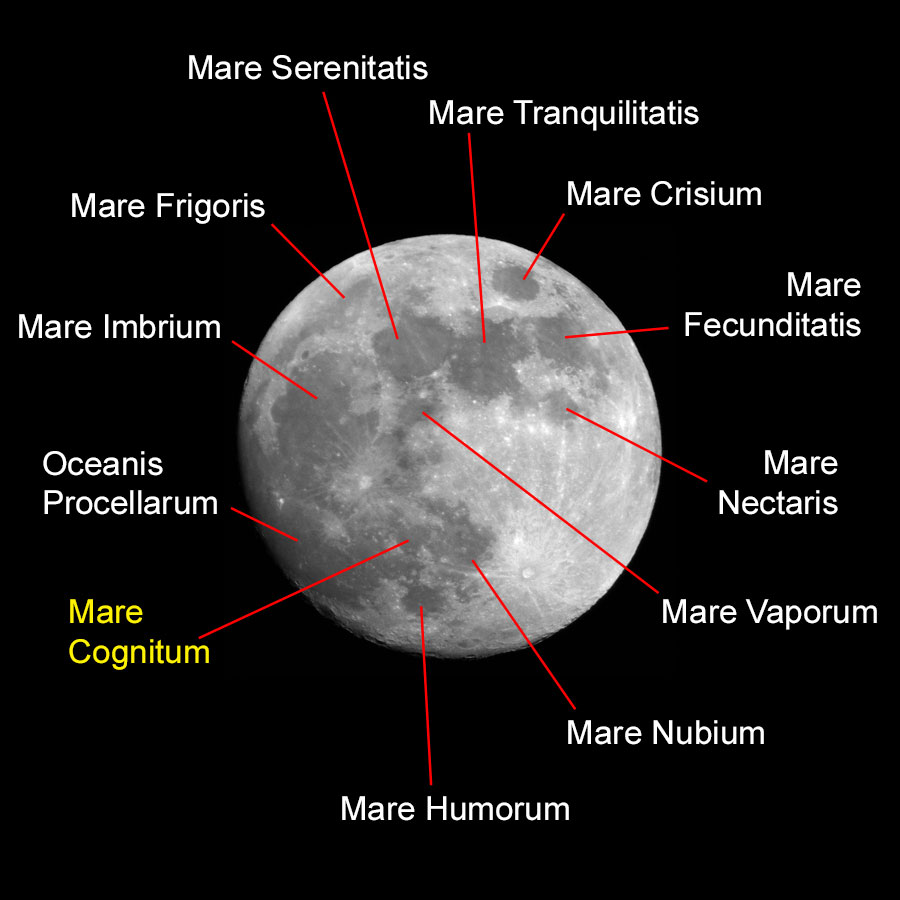 |
Photo data (left photo): March 29, 2018 (two days before Full Moon), Sky-Watcher
Skymax-127 OTA, Sony RX100 M4 attached to the 32 mm eyepiece
Photo data (right photo): February 28, 2010 (nearly Full Moon), Sky-Watcher
Skymax-127 OTA (probably), Leica X Vario (36 - 50 mm equiv.) held to a 32 mm
eyepiece (47 x)
Copernicus
The crater Copernicus has a diameter of 93 km and is 3800 m deep (Spix). According to Spix, many consider Copernicus to be the most beautiful moon crater of all. At full moon or shortly before you can see an extended system of rays emanating from Copernicus.
 |
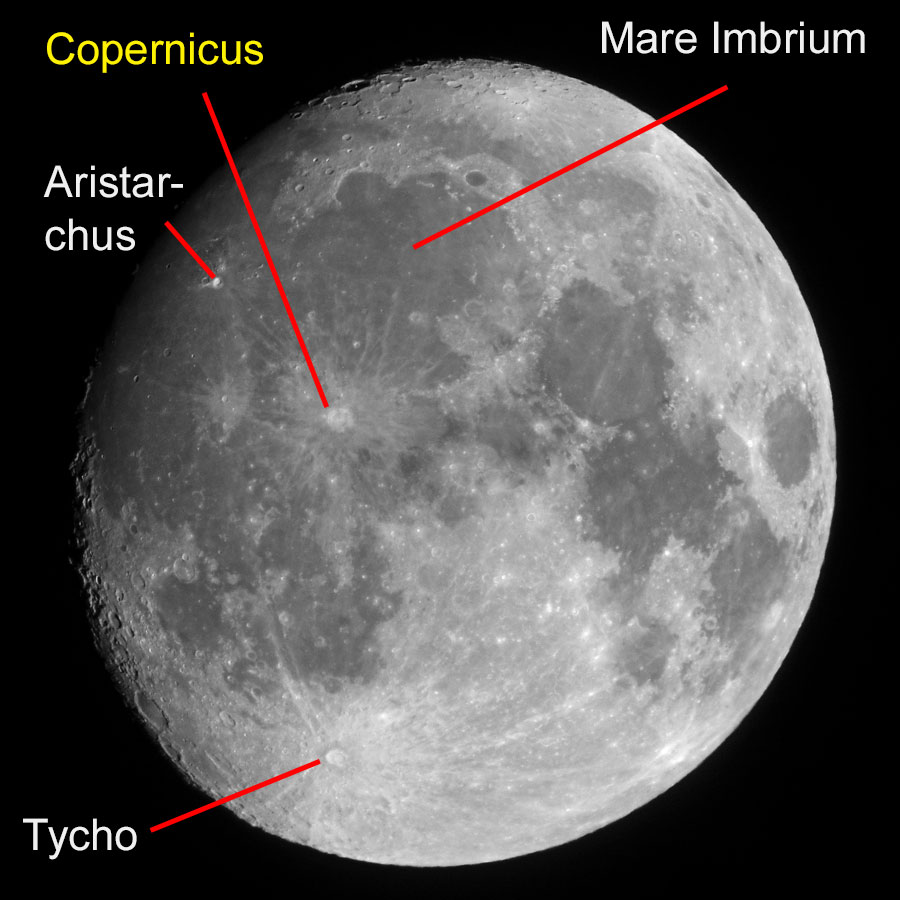 |
Section from the photo above:
Photo data: November 20, 2018, Omegon PS 72/432 refractor, Sony RX100 M4 attached to the 32 mm Digiscope eyepiece, 3 x focal extender (40.5 x)
Crisium, Mare (Sea of Crises)
Mare Crisium (diameter 550 km according to Spix) at the right edge of the moon can be seen well in the third night after new moon, especially the crater walls surrounding it (left and center photo). At half moon only the dark lava surface can be seen (right photo).
 |
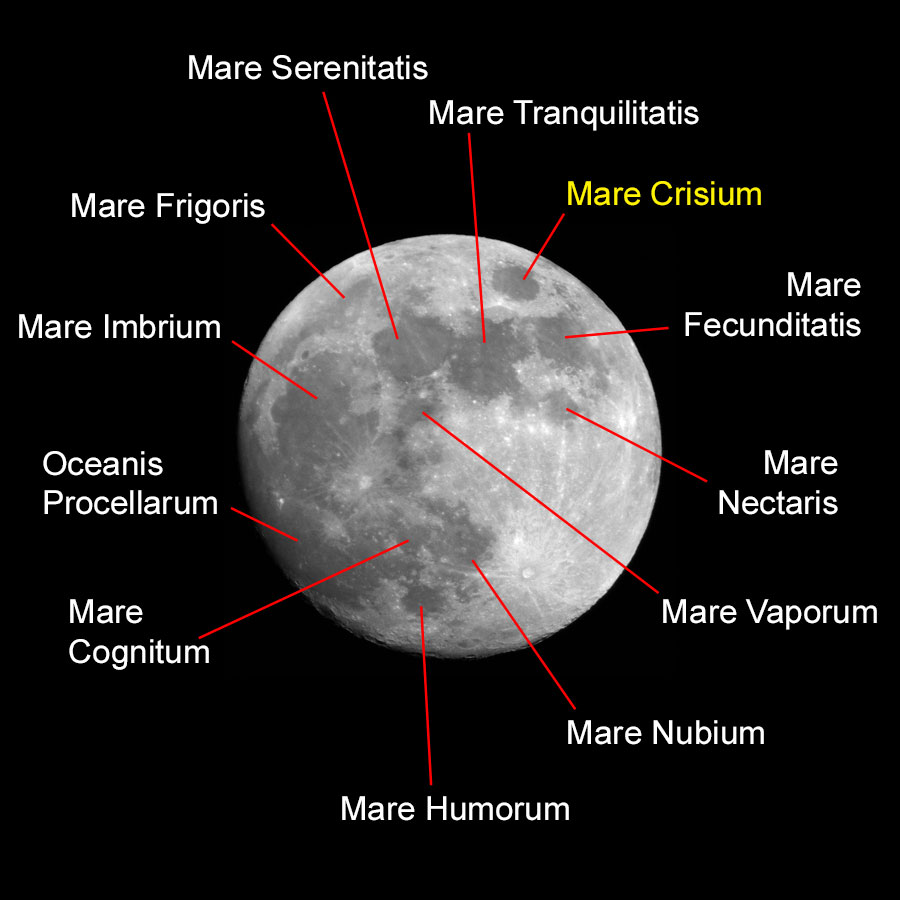 |
Photo data (left photo): March 29, 2018 (two days before Full Moon), Sky-Watcher
Skymax-127 OTA, Sony RX100 M4 attached to the 32 mm eyepiece
Photo data (right photo): February 28, 2010 (nearly Full Moon), Sky-Watcher
Skymax-127 OTA (probably), Leica X Vario (36 - 50 mm equiv.) held to a 32 mm
eyepiece (47 x)
Cyrillus
The ring mountains (large crater) Theophilus has a diameter of 98 km and is 3400 m deep (Spix). It is the first in a chain of three craters called Theophilus, Cyrillus, and Catharina at the northwestern edge of Mare Nectaris (Sea of Nectar).
 |
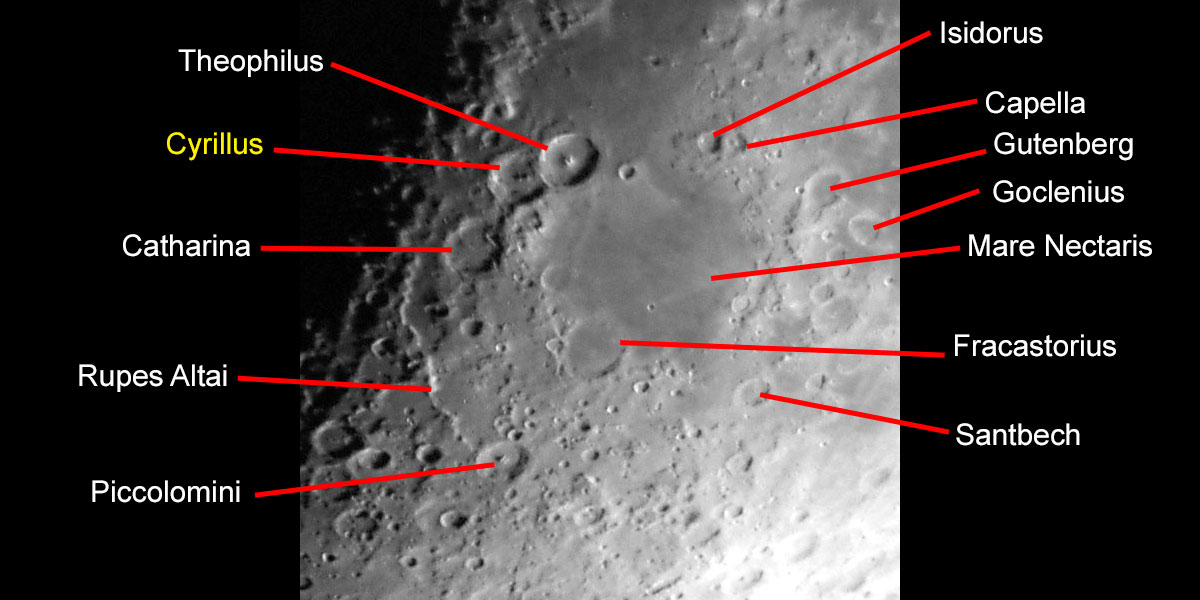 |
|
 |
 |
Photo data: April 2-3, 2017, Sky-Watcher Explorer 150PDS, Ricoh GR held to the 7 mm UWA eyepiece
References
- Mond (Wikipedia): de.wikipedia.org/wiki/Mond
- Moon (Wikipedia): en.wikipedia.org/wiki/Moon
- Lambert Spix (2013, 3. Auflage). moonscout - Mondmeere, Krater und Gebirge einfach finden und beobachten. Oculum-Verlag. ISBN 978-3-938469-58-3
- Lambert Spix & Frank Gasparini (2011, 1. Auflage). Der Moonhopper. Oculum-Verlag. ISBN 978-3-938469-54-5
- Ronald Stoyan, Hans-Georg Purucker (2013, 1. Auflage). Reiseatlas Mond. Oculum-Verlag. ISBN 978-3-938469-64-4
- Virtual Moon Atlas: ap-i.net/avl/en/start
| 11.12.2018 |
